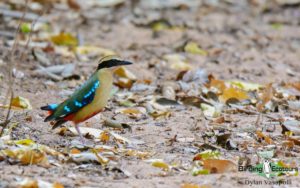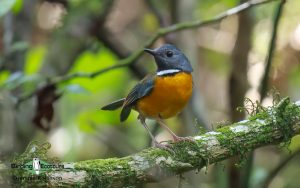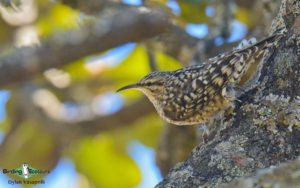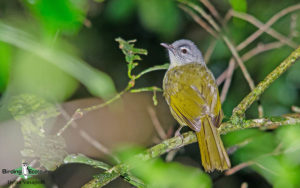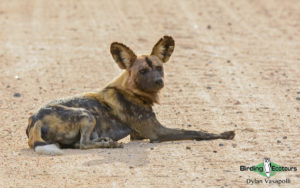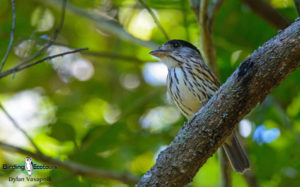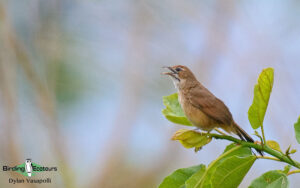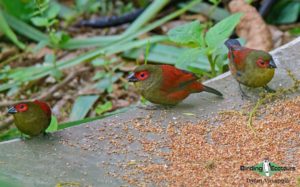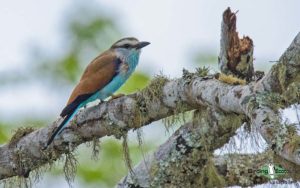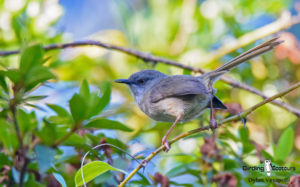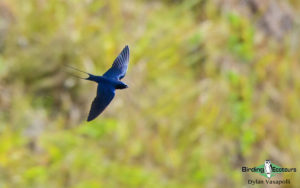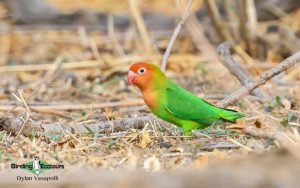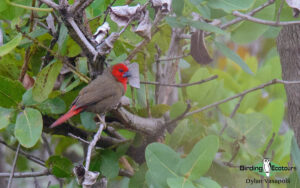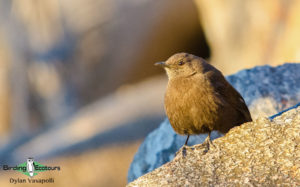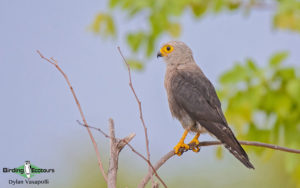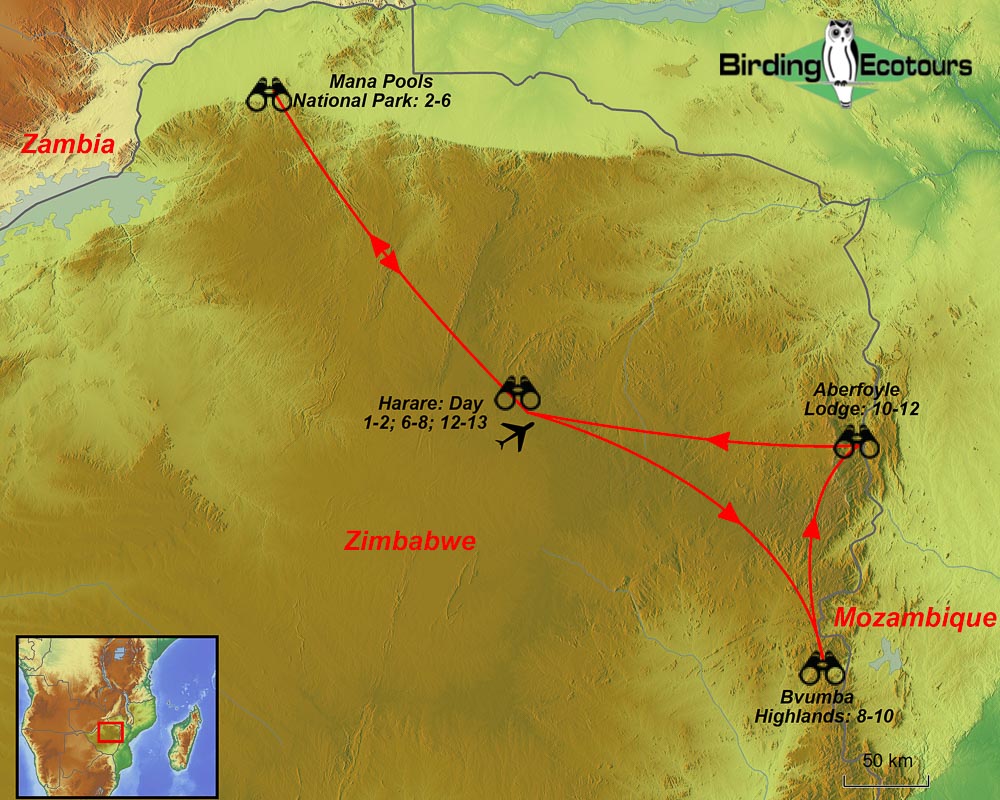Zimbabwe Birding Tour: African Pitta, Mana Pools, Miombo Woodlands and Eastern Highlands
Zimbabwe Birding Tour: African Pitta, Mana Pools, Miombo Woodlands and Eastern Highlands
November 2026/2027
Zimbabwe is an absolutely fabulous country – scenically wonderful, with very friendly people fluent in English and a long history in wilderness conservation. This has led to the establishment of a number of excellent and highly biodiverse reserves and national parks throughout the country. Zimbabwe has a good road network, and it also holds the distinction of being one of the few African countries in which you can see a great deal without the use of a 4×4 vehicle. With an improving political leadership and the introduction of US Dollars as tender throughout the country, Zimbabwe is once again becoming a very popular destination for birders and travelers alike.
This tour starts in the country’s capital city, Harare, before we soon transition to the famous Mana Pools National Park, a lush reserve at the bottom of the breathtaking Zambezi River Valley (here, the Middle/Lower Zambezi, one of Africa’s biggest rivers, is bounded by steep and immense escarpments on either side) and full of excellent birds. Some of our early highlights are likely to include the highly desired African Pitta (for which this tour is specifically timed), the localized Lilian’s Lovebird and a wide spectrum of mammals. Indeed, Mana Pools is a famous predator viewing area, with high concentrations of Lion, Leopard and the rare African Wild Dog, all serving as a precursor to the wonders that await.
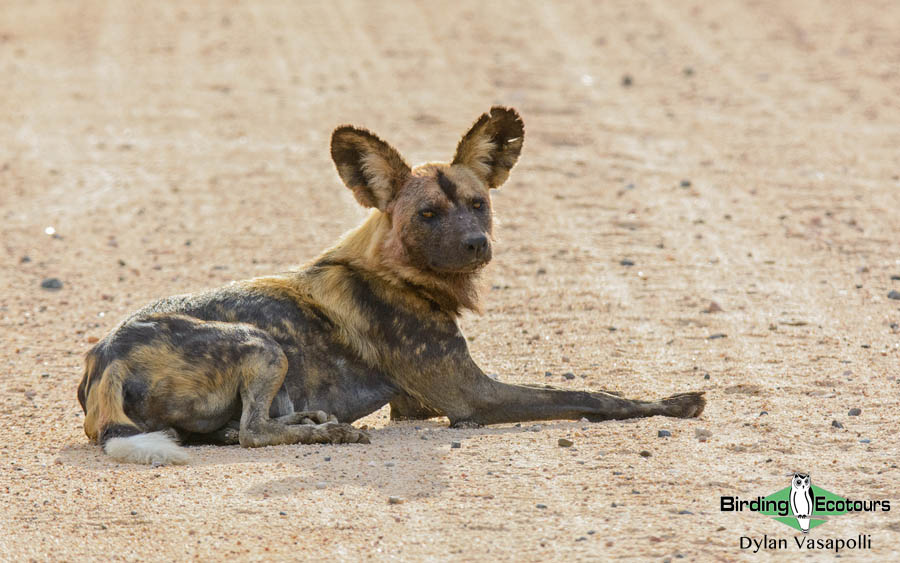
After a few days in magical Mana Pools, we make our way back south to Harare where we visit various miombo woodland birding areas around the city for the day – this is a unique south-central-African-restricted woodland that has a whole host of bird species restricted solely to this habitat and is of significant importance!
After a full day of Harare miombo birding, we transition to the spectacular Eastern Highlands for the next leg. The Eastern Highlands’ evergreen forests hold some highly localized endemics such as Chirinda Apalis and Roberts’s Warbler, as well as several birds that are more easily found here than in other countries, such as Swynnerton’s Robin. We also bird mountain grasslands for the Vulnerable (IUCN) Blue Swallow, this area being one of the last remaining strongholds for this scarce, rapidly declining species.
After four nights in Zimbabwe’s lush Eastern Highlands, we make our way back to Harare (birding our way back, of course) where the tour ends after a final night in the capital city. This exciting Zimbabwe birding tour gives you the opportunity to find the near-mythical African Pitta while also taking in some highly range-restricted specials, along with some truly spectacular megafauna highlights too.
This Zimbabwe birding tour incorporates four nights in an all-inclusive, private lodge in Mana Pools National Park, which is one of Africa’s great wildlife havens. Mana Pools has proven to be one of the most reliable locations for finding the most-wanted African Pitta, around which this tour is designed.
For those who would like to target several range-restricted and tricky-to-find Mozambique specials, you can join our Mozambique Birding Tour: Crab-plover and Lowland Forests which immediately follows this Zimbabwe bird watching tour. On this trip we spend time in the lowland forests of central Mozambique looking for White-chested Alethe, East Coast Akalat, Chestnut-fronted Helmetshrike and other desirable specials. We then move south to the coast where we search for Crab-plover, Saunders’s Tern and many other coastal birds.
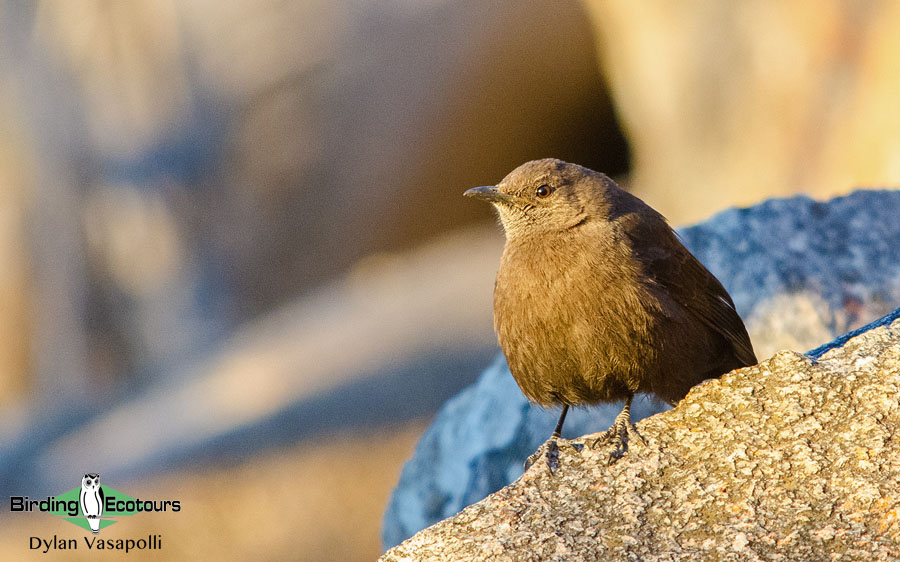
Itinerary (13 days/12 nights)
Day 1. Arrival in Harare
Our international flights arrive in Zimbabwe’s capital, Harare, (usually by midday), and we transfer to our comfortable guest house within this city’s suburbs, where we spend the first night. The gardens sometimes host Variable Sunbirds, barbets and other dazzling species. If this is your first trip to Africa, prepare to be swamped with new birds, many of them brightly colored. In the afternoon, time permitting, we will try to track down the prized Boulder Chat just outside of Harare. Here, we will get our first taste of miombo birding, which is likely to produce Miombo Rock Thrush, Southern Hyliota, Red-faced Crombec and Eastern Miombo Sunbird. More widespread species also occur around here, and are likely to include Southern Yellow White-eye and Tropical Boubou.
Overnight: Harare
Days 2 – 5. Mana Pools National Park
Today, we will have a long transfer (roughly five hours of travel time) to reach our next destination of the trip – Mana Pools National Park, and thus we will be keen to get going early. While the trip to Mana Pools will likely be uneventful, stops en-route, such as around Lion’s Den, may provide us with species such as Black-chested Snake Eagle, Red-faced Cisticola, Copper Sunbird and the highly prized Racket-tailed Roller. Eventually, we will descend sharply into the verdant Zambezi Valley, and proceed onwards to our comfortable and well-appointed exclusive lodge, in time for our late afternoon birding.
At this time of the year, the area regularly has good numbers of displaying African Pittas and from our first afternoon, we will be on the lookout for these mythical and most-wanted intra-African migrants. Four nights and three full days in Mana Pools will give us excellent chances of finding pittas while also giving us ample time to enjoy the area’s rich birdlife, not to mention the impressive numbers of megafauna in the area.
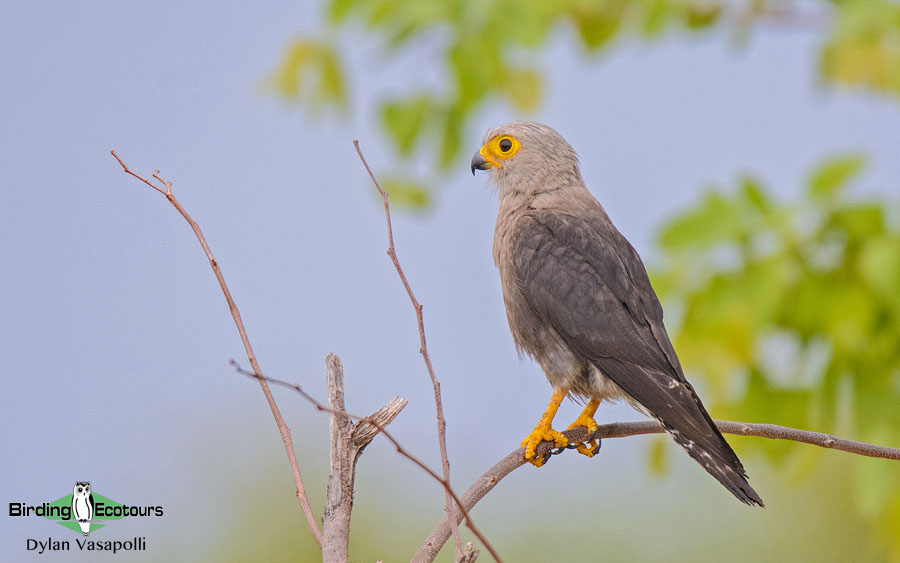
Mana Pools is another of Africa’s great game parks, and it is one of the continent’s premier wildlife-viewing areas! Like their mammal counterparts, the birdlife within the area is nothing short of outstanding – with an incredibly diverse array of species, including some very special birds, all awaiting us! We will spend four nights in the area, and our time will be taken up with a mix of birding/wildlife drives as we navigate through the area. We will also undertake short walks through the wilderness – mostly in our pursuit of African Pitta. Our focus will be on the birds and mammals alike in this area, and we find that the two work in perfect harmony with each other. A wide range of habitat is covered, from mixed bushveld on rocky slopes covered in baobab trees, sections of tall, gallery mopane woodland, through to dense riverine thickets, dry riverbeds, and large areas of open riverine woodland, with scattered pans and wetlands dotted throughout the region. The mighty Zambezi River flows through the park and is the primary reason for the incredible diversity here.
Although the bird species occurring here are too many to mention, we will focus our efforts on the following ‘specials’. The range of mixed woodlands, bushveld and baobab-dominated areas host one of our core targets, Lilian’s Lovebird, along with the likes of both Mottled and Böhm’s Spinetails, Bennett’s Woodpecker, Dickinson’s Kestrel, Meyer’s Parrot, Retz’s Helmetshrike, Mosque Swallow and Orange-winged Pytilia. Many raptors nest within these areas, and we should keep our eyes open as African Harrier-Hawk, Hooded and White-backed Vulture, Brown Snake Eagle, Bateleur, Martial and Tawny Eagles, African Hawk-Eagle, Lizard Buzzard, Dark Chanting Goshawk and Shikra, are all likely. We will search areas of mopane woodland for the scarce Arnot’s Chat and if we’re lucky, Racket-tailed Roller.
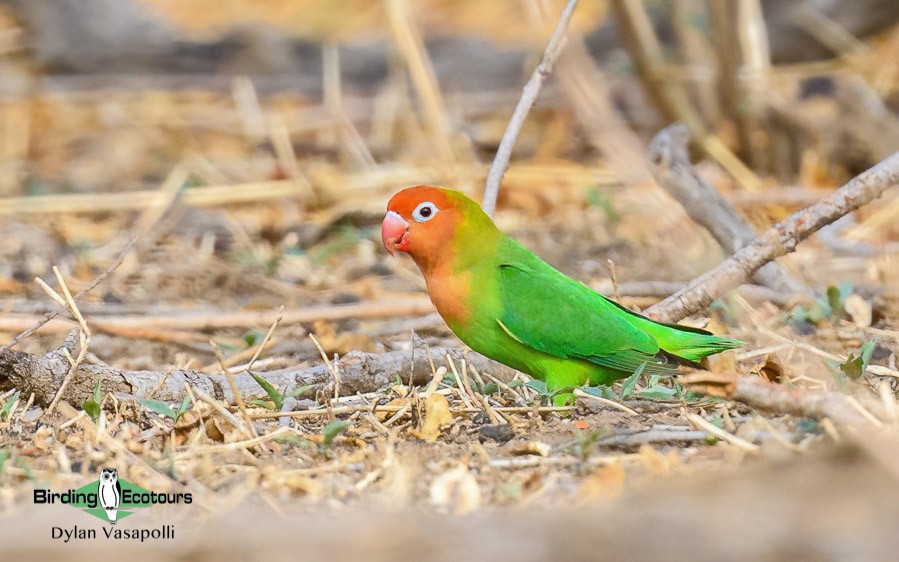
The denser thickets, often lining some of the smaller streams and dry riverbeds, will be searched for many denizens, most importantly African Pitta, along with the likes of Crested Guineafowl, Narina Trogon, Eastern Nicator, the localized Livingstone’s Flycatcher, Purple-banded Sunbird and Red-throated Twinspot, amongst others.
A day trip from our lodge to visit the many wetlands and pans, along with the Zambezi River itself, should produce a wide array of waterbirds, and we’re sure to find a number of ducks, plovers, storks, herons and egrets here. Some of the more important species we’ll be targeting include Long-toed and White-crowned Lapwings, Greater Painted-snipe, Collared Pratincole, Saddle-billed Stork and Goliath Heron. Western Banded Snake Eagle can often be found in the trees surrounding these water bodies, and we may also stumble upon the highly prized Pel’s Fishing Owl if we’re very lucky. Nocturnal birding can also be rewarding here, and the bulk of our focus will be on finding the scarce Three-banded Courser. Other species such as African Barred Owlet, Verreaux’s Eagle-Owl and African Wood Owl are usually around, along with Fiery-necked Nightjar and even the spectacular Pennant-winged Nightjar.
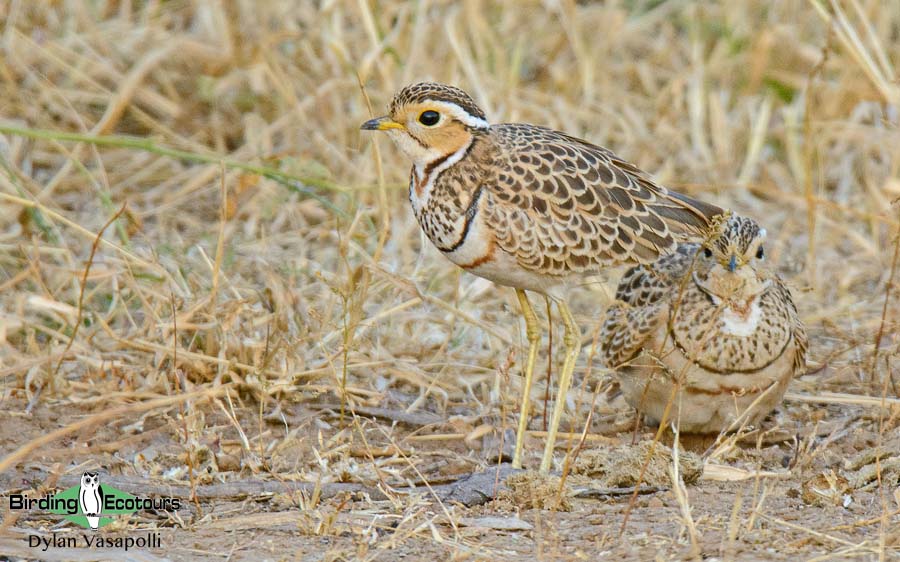
Mana Pools is famous for its vast numbers of African Elephants and its predator sightings, in particular African Wild Dog, with several packs of this rare and highly prized predator occurring throughout the park. Additionally, Lion and Leopard are regularly seen. Some of the other mammals we are likely to see here include African Buffalo, Greater Kudu, Eland, Waterbuck, Plains Zebra and Hippopotamus. We also have a chance of seeing some of the more nocturnally active mammals found here such as African Civet, Side-striped Jackal, Spotted Hyena and Honey Badger.
Overnight: Mhara River Camp, Mana Pools
Day 6. Mana Pools to Harare
We have a full final morning available to explore the area, granting us the opportunity to search for any of the birds and mammals mentioned above (Days 2 – 5), that we may not have seen yet. Eventually, we will need to depart this incredible wildlife park, and make the trip back to Harare (roughly five hours). En-route we will likely stop off again in the Lion’s Den area where we can look for Marsh Owl, Croaking Cisticola, Bat Hawk and several other exciting species. We will then likely arrive in the late afternoon, and will settle in for our evening meal together, with the exciting prospect of a full day of miombo birding the following day!
Overnight: Harare
Day 7. Birding Harare
Harare is a birdy city, with the lush gardens and woodlands allowing birdlife to thrive. Additionally, the city and some of the surrounding areas on the Mashonaland Plateau host some of the finest tracts of the unique miombo woodland in the country. Dominated by Brachystegia trees, covered in lichen and moss, this woodland hosts several species virtually confined to these patches. We have a full day at our disposal to explore some of the birding sites in and around Harare, specifically targeting the miombo specials. Birding in the miombo can be tough going, with the birds often confined to ‘bird parties’ – where groups of birds gather, forage and feed together, slowly moving through the woodland. With enough time, we are bound to come across a few of these ‘bird parties’. Species such as White-crested Helmetshrike and Green-capped Eremomela are often the first birds to be found, before the trees come alive with other species. Some of our primary targets will be species such as Southern Hyliota, White-breasted Cuckooshrike, Green-backed Honeybird, Red-faced Crombec, Miombo Tit, Grey Penduline Tit, Stierling’s Wren-Warbler and Cabanis’s Bunting. Harare is a great place to see Whyte’s Barbet, and we will hopefully come across this prized barbet during our stay.
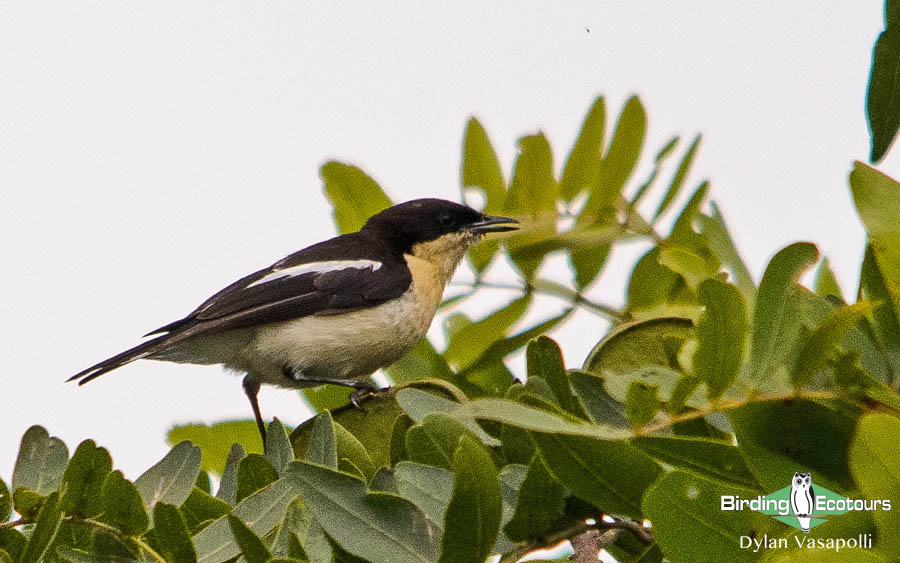
Harare is also famous for the excellent tropical wetland birding it hosts – however, this is only during the rainy summer season (Jan – Mar), and the majority of the wetlands will be dry at this time of the year. Despite this, we may still find residents such as Marsh Owl, Senegal Coucal, African Yellow Warbler, a trio of longclaws, Cape, Yellow-throated and the prized Rosy-throated Longclaws, Orange-breasted Waxbill and Yellow-mantled Widowbird.
Overnight: Harare
Day 8. Transfer to Bvumba Mountains, woodland birding en route
Today, we plan to leave early and embark on a half-day drive to the Eastern Highlands of Zimbabwe near the border with Mozambique, and then upwards to the mid altitudes of the Bvumba Mountains. We have a fair distance to cover today, but en-route we’ll be sure to spend some time birding around Gosho Park, just east of Marondera, for any miombo birds we might have missed near Harare. Gosho Park is another fantastic site, and it allows us our best chances for some species such as African Spotted Creeper, Whyte’s Barbet, Miombo Rock Thrush, Miombo Tit, Wood Pipit, Western Violet-backed Sunbird and Black-eared Seedeater. Time-dependent, we may also bird some woodlands near Mutare for the uncommon and range-restricted Cinnamon-breasted Tit.
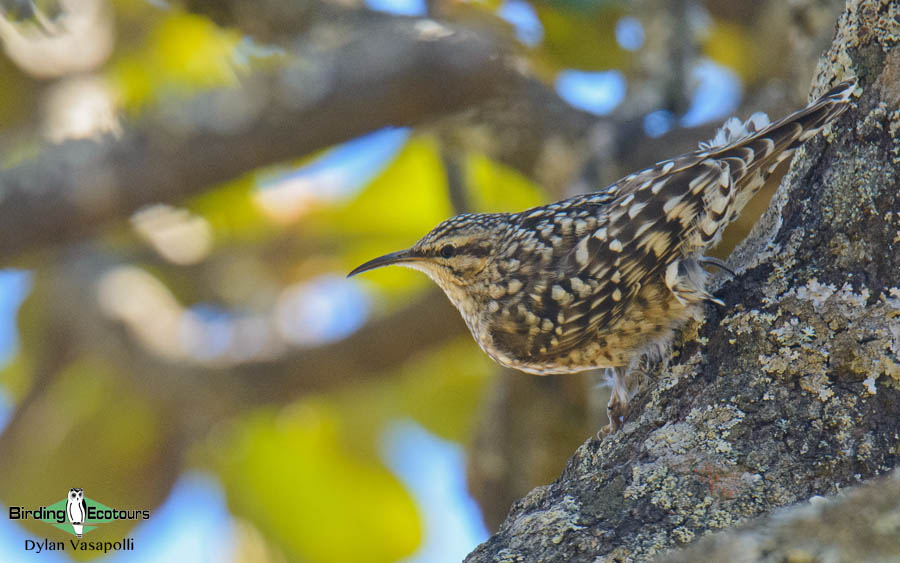
Eventually, we reach the lush Bvumba Highlands where we will stay at the rustic yet charming Seldomseen Cottages, set right within some of the best montane forest in the region. Here, almost all of the Eastern Highlands’ forest species occur right on our doorstep! We will spend two nights here, birding the lush grounds and their surrounds. We will likely spend the afternoon exploring the Seldomseen grounds and familiarizing ourselves with some of the specials occurring in the area. Common and vocal species we’re likely to see include some of the area’s prized birds, such as Chirinda Apalis, Roberts’s Warbler and Stripe-cheeked Greenbul, while other more widespread species such as Cape Batis, Olive Bushshrike, Cape Robin-Chat, African Dusky Flycatcher, Olive Thrush and Olive Sunbird abound in the grounds.
Overnight: Seldomseen Cottages, Bvumba Highlands
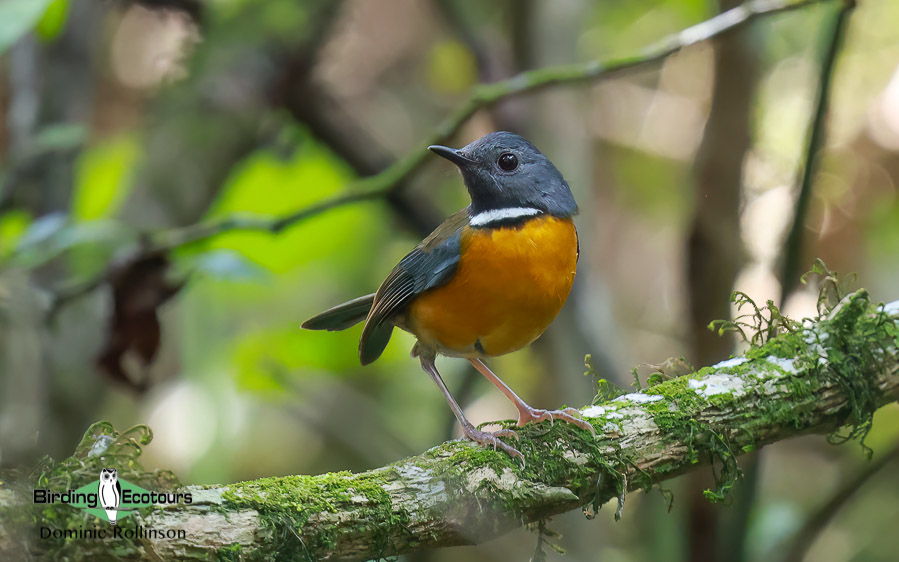
Day 9. Continued birding in the Bvumba Highlands
We have the full day to explore this area to try and find all its many special birds. The Eastern Highlands also host some excellent miombo woodlands, and we will be sure to include some time in these during our stay. These woodlands are the primary range for the scarce Cinnamon-breasted Tit, and this species will likely be our main target. Of course, these woodlands support the full array of miombo specials, and if we missed any species such as African Spotted Creeper, Cabanis’s Bunting, Whyte’s Barbet, Red-faced Crombec, Miombo Rock Thrush and Miombo Tit, we will be able to try again for these species. We may also be lucky and find one of the ‘regular’ Collared Flycatchers here (this is a rare migrant to southern Africa), while the grassy slopes are good for the scarce Tree Pipit.
We will need to put more time into the forested areas, as they host the bulk of the specials, and the very localized Swynnerton’s Robin will be one of our main targets. Noisy Livingstone’s Turacos bound in the treetops, while secretive Eastern Bronze-naped Pigeons call from high up within deep cover, with dainty White-tailed Crested Flycatchers never far away. The understory, however, is often of more importance, supporting the likes of Orange Ground Thrush, Barratt’s Warbler, White-starred Robin, Green Twinspot and the ultra-secretive Buff-spotted Flufftail, this being one of the best areas to see the latter! Black-fronted Bushshrikes keep to the thicker tangles, while species such as Yellow-rumped Tinkerbirds aren’t shy to show themselves, with Lemon and Tambourine Doves exploding from the forest floor. The open areas play host to species such as Cape Grassbird, African Yellow Warbler, Singing Cisticola and the cute Yellow-bellied Waxbill, while some of the protea-clad hills and flowering trees support a wealth of nectar-loving species, such as Bronzy Sunbird and if we’re lucky, Gurney’s Sugarbird. Raptors abound in this area, and we’ll be sure to keep our eyes out for Crowned and Long-crested Eagles, along with Augur Buzzard, while the smaller African Goshawk and Black Sparrowhawk are never far away from forested areas.
Overnight: Seldomseen Cottages, Bvumba Highlands
Day 10. Transfer to Aberfoyle Lodge, woodland birding en route
We will have one final morning to perhaps target any missing forest specials before we make our way north to the Honde Valley and Aberfoyle Lodge. One of our stops en route will see us calling into the incredible Nyanga Mountains where we will focus our attention on the scarce Blue Swallow – here at one of the last strongholds for this species. After making our way down along the winding Honde Valley road, we will eventually reach the comfortable Aberfoyle Lodge, where we will be based for two nights.
Overnight: Aberfoyle Lodge, Honde Valley
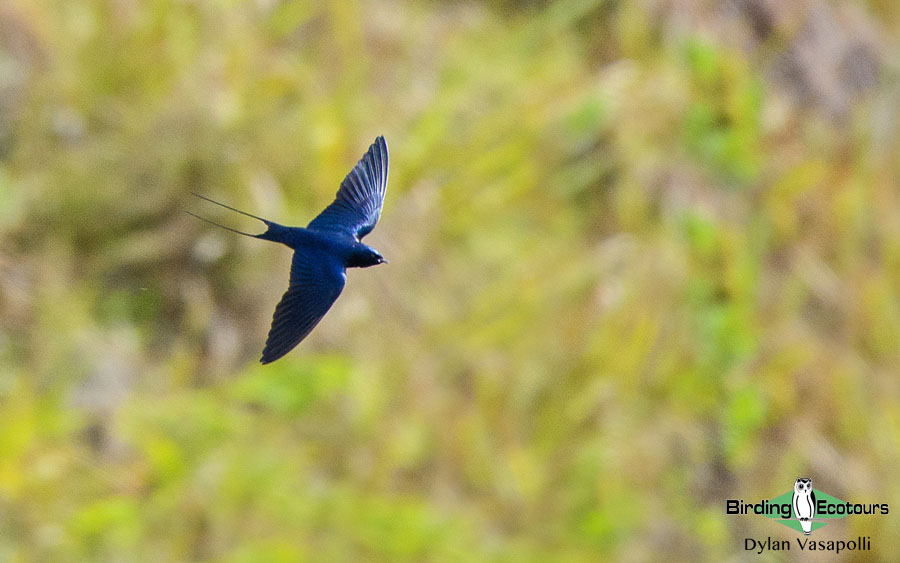
Day 11. Birding Aberfoyle Lodge and the Honde Valley
After our late afternoon arrival the previous day, this will be our first chance for birding this incredible area. We will spend the day visiting sites around the Honde Valley, such as the famous ‘Wamba Marsh’, Katiyo Tea Estate and the expansive grounds of the lodge itself. The Honde Valley is a scenic area with huge tea estates punctuated by villages, subsistence farmland and small patches of attractive riverine forest. The Mutarazi Falls can be seen in the distance as they plummet an impressive 2,500 feet (~760 meters) from the Nyanga Highlands which tower above this fertile valley. Feeders around the lodge attract some strikingly beautiful birds such as Red-throated Twinspot and Red-faced Crimsonwing, and nearby riverine forests are home to the scarce Pallid Honeyguide, Silvery-cheeked Hornbill, White-eared Barbet, African Broadbill, Common Square-tailed Drongo, and as always, many others. The rivers running through the area host Half-collared Kingfisher and Mountain Wagtail. Ayres’s Hawk-Eagle is often seen in the area, as is Palm-nut Vulture. Keeping an eye skywards might produce sightings of Scarce and Mottled Swifts, both of which have colonies in the area, and are a regular sight overhead. Lesser Seedcracker is the most sought-after bird here in the Honde Valley, and while we’ll allocate a good amount of time looking for it, this remains one of the toughest trip birds, and it’s certainly easy to miss.
Some of the outlying areas away from the lodge host other exciting species such as Blue-spotted Wood Dove, Green-backed Woodpecker, Moustached Grass Warbler, Fan-tailed Grassbird (Broad-tailed Warbler), Marsh Tchagra, Singing Cisticola, Grey Waxbill, Magpie Mannikin and Black-winged Red Bishop, amongst others. This is a very birdy area, and we are sure to see a high number of species as we traverse the valley.
Overnight: Aberfoyle Lodge, Honde Valley
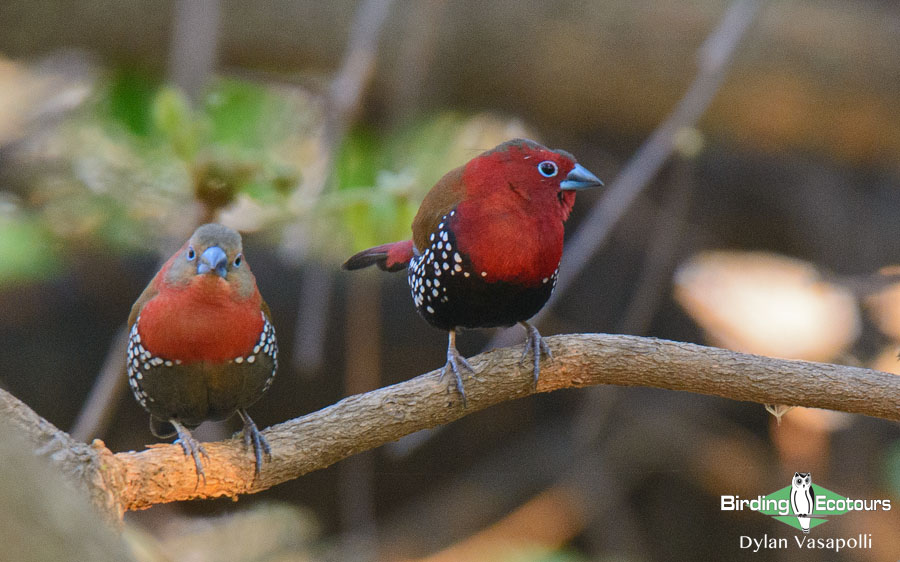
Day 12. Transfer from Honde Valley to Harare
We will have a final morning’s birding in the Honde Valley, perhaps having another search for the rare Lesser Seedcracker, before moving back westwards towards Harare. Today is mostly a transfer day; however, we can also use it as a backup day to look for any missing targets, perhaps spending more time in the miombo woodlands looking for specials such as Green-backed Honeybird or African Spotted Creeper. We will likely arrive in Harare in the late afternoon and enjoy one final group dinner this evening.
Overnight: Harare
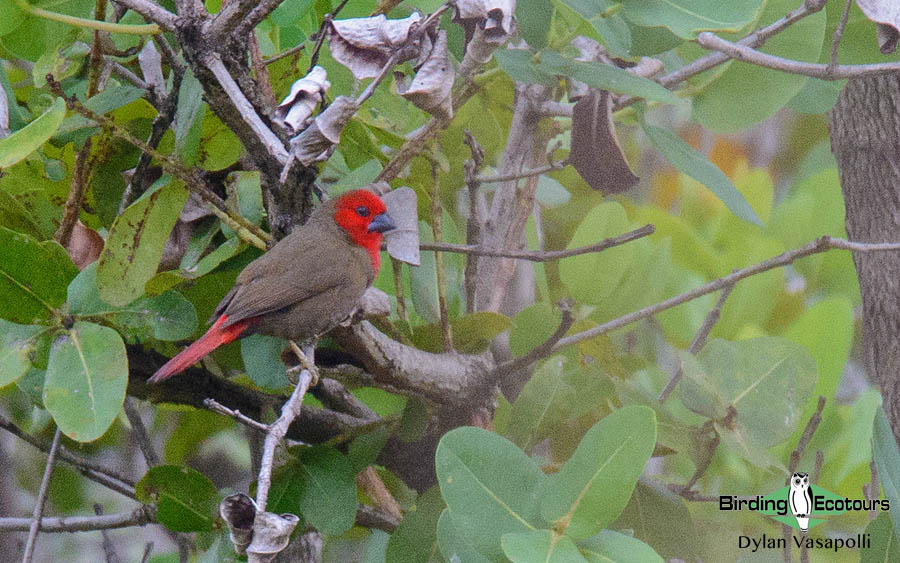
Days 13. Departure from Harare
The tour comes to an end after breakfast – where you can depart at your leisure. Please note that there are no activities scheduled for the day, however, should you have a late afternoon/evening departure from Harare, we will be able to assist in organizing activities for you.
Please note that the itinerary cannot be guaranteed as it is only a rough guide and can be changed (usually slightly) due to factors such as availability of accommodation, updated information on the state of accommodation, roads, or birding sites, the discretion of the guides and other factors. In addition, we sometimes have to use a different international guide from the one advertised due to tour scheduling.
Download ItineraryZimbabwe Set Departure Birding Tour: African Pitta, Miombo Woodlands and Eastern Highlands Tour Report, November 2024
21 NOVEMBER – 03 DECEMBER 2024
By Dominic Rollinson
DOWNLOAD TRIP REPORT
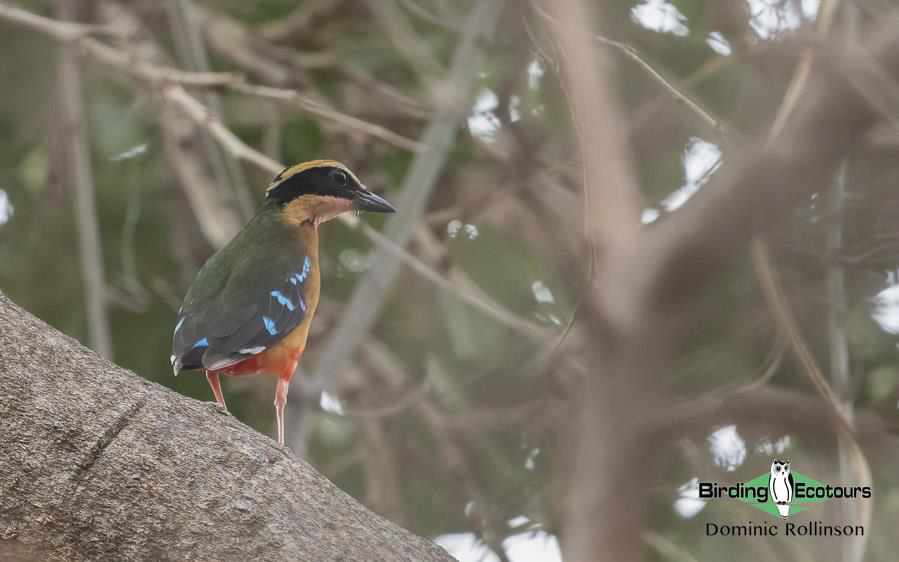
We had several good looks at the tour’s major target, African Pitta, in Mana Pools.
Overview
This Zimbabwe birding tour took in a good cross-section of this bird-rich southern African country, which meant we were able to amass an impressive bird list while also enjoying many large and charismatic mammals. As the name of this tour suggests, the trip was first and foremost designed around finding the elusive and enigmatic African Pitta, which is only realistically possible in late November up until mid-December in southern Africa. To find pittas we visited Mana Pools National Park in northern Zimbabwe, a wildlife haven in the Zambezi River valley, which is a prime breeding ground for African Pitta. From northern Zimbabwe we made our way back south to the capital, Harare, where we spent time birding in miombo woodlands, looking for a suite of range-restricted miombo specials. Our 13-day trip ended with a few days in the Eastern Highlands, where we targeted several range-restricted Afromontane specials, such as Swynnerton’s Robin, Red-faced Crimsonwing and White-tailed Crested Flycatcher.
We recorded 363 bird species on this Zimbabwe birding tour, with many highlight species being seen. Some of our standout species included African Pitta, Lilian’s Lovebird, Livingstone’s Flycatcher, Dickinson’s Kestrel, Red-necked Falcon, Three-banded Courser, Livingstone’s Turaco, Racket-tailed Roller, Boulder Chat, African Spotted Creeper, Miombo Rock Thrush, Southern Hyliota, Swynnerton’s Robin, Red-faced Crimsonwing, White-tailed Crested Flycatcher, Stripe-cheeked Greenbul, Pallid Honeyguide, Moustached Grass Warbler, Red-winged Prinia, Chirinda Apalis and Roberts’s Warbler.
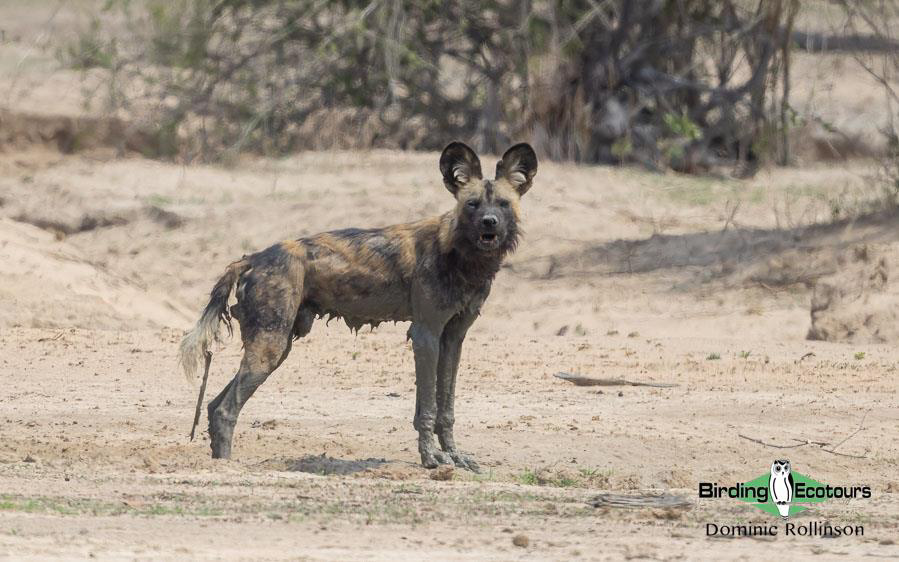
African Wild Dog was a big mammalian highlight while in Mana Pools.
We also found an impressive array of mammals on this tour, with our time in Mana Pools being particularly productive. Some of the highlights on the mammal front included African Wild Dog, Side-striped Jackal, Lion, African Savanna Elephant, Sharpe’s Grysbok, Mutable Sun Squirrel, Blue Monkey, Southern Lesser Galago, Common Hippopotamus, Common Eland and Giraffe.
A detailed daily account can be read below, with the full bird, mammal and reptile lists located at the end of the report.
Detailed Report
Day 1, 21st November 2024. Arrival and afternoon birding in Harare
As Curt and Christiane had arrived the previous day, we decided to get an early start with our birding and headed out to Mukuvisi Woodlands, on the outskirts of Harare, to get started with our miombo birding. Upon our arrival in the woodlands the birding activity was high, and we quickly got the bird list started. Some of our more exciting finds during our morning at Mukuvisi included Whyte’s Barbet, African Golden Oriole, White-crested Helmetshrike, White-breasted Cuckooshrike, Lesser Blue-eared Starling (a recent lump with Miombo Blue-eared Starling) and Eastern Miombo Sunbird. The small dam further held White-faced Whistling Duck, Black Crake, African Wattled Lapwing, Hamerkop and African Yellow Warbler. A single Bronze-winged Courser on the edge of the miombo woodland was an unexpected find.
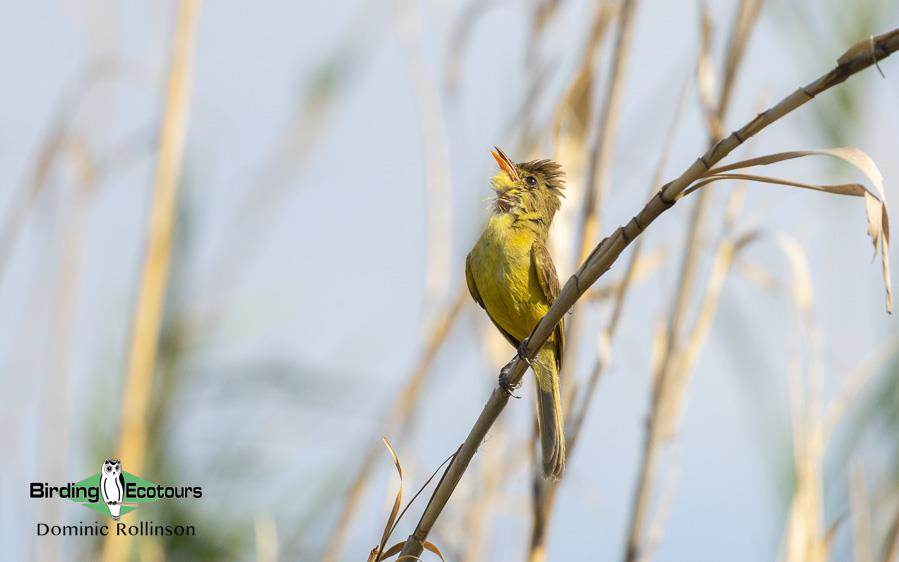
African Yellow Warbler duly obliged around Harare.
Later that afternoon we headed out to Monavale Marsh to look for a few wetland species. The marsh was mostly dry, nevertheless, the surrounding areas held Senegal Coucal, Gabar Goshawk, Levaillant’s Cisticola, African Yellow, Little Rush and Common Reed Warblers, Yellow Bishop, White-winged, Yellow-mantled and Red-collared Widowbirds and Orange-breasted Waxbill. We then headed back to our guest house in Harare after what had been a good introduction to Zimbabwean birding.
Day 2, 22nd November 2024. Transfer to Mana Pools – AFRICAN PITTAS!
We had an early start today as we were to make the long drive north to Mana Pools National Park. As we left Harare, we found a few interesting species such as Black-winged Kite, Black-headed Heron and Abdim’s and White Storks. The drive was mostly uneventful, with the road steadily deteriorating as we made our way north.
Around midday we arrived at the entrance gate to Mana Pools and, as we were filling in our paperwork, we added our first Mottled Spinetail and Crowned Hornbill of the trip. Shortly afterwards we met up with Jim and Liam, our expert local guides who would be hosting us at Mhara River Camp for the next four nights. We hopped into the open-top safari vehicle (which would be our own private vehicle for our time around Mana Pools) and drove the remaining two hours to camp. Despite the heat of the day, it was difficult to not get excited by the new birds continually showing for us and a few stops along the way added Meves’s Starling, Southern Red-billed Hornbill and Brown Snake Eagle.
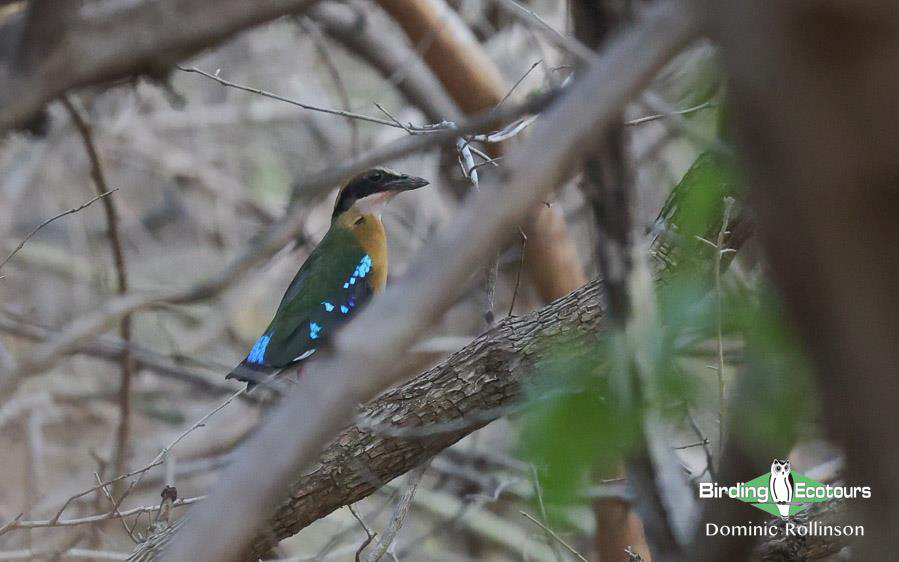
Our initial views of African Pitta were rather obstructed by thick riverine vegetation.
We eventually made it to Mhara River Camp where we enjoyed a tasty lunch and then jumped back into the vehicle for our first proper birding drive. We went straight down to the thick riverside vegetation, where we soon found African Broadbill and were really excited to hear displaying African Pitta. After much careful positioning we laid eyes on a pair of these most wanted and enigmatic species. The views were satisfactory, however, we were hoping for something a little better and decided we would revisit this pair over the next few days.
Days 3-5, 23rd-25th November 2024. Mana Pools birding
The next three full days were spent birding around Mhara River Camp’s private concession (which we had entirely to ourselves) or birding at Mana Pools itself. Our days generally involved very early pre-dawn starts with an open-top safari drive, which ended in the late morning, after which we would enjoy some downtime during the heat of the day. In the late afternoons we enjoyed another safari drive which ended with sundowners and a bit of a night drive.
Birding around Mhara River Camp’s private concession was exceptional and over the next few mornings and late afternoons we concentrated on improving our African Pitta views. With patience and hard work we eventually all had amazing looks at these brightly colored yet difficult-to-see targets. Other top-quality species seen while birding the riverine vegetation included Southern Crested Guineafowl, Natal Spurfowl, Crowned Hornbill, Livingstone’s Flycatcher, African Broadbill, Broad-billed Roller, Red-throated Twinspot, African Golden Oriole, White-crested Helmetshrike, Tropical Boubou, Bearded Scrub Robin, Southern Yellow White-eye and Green-winged Pytilia.
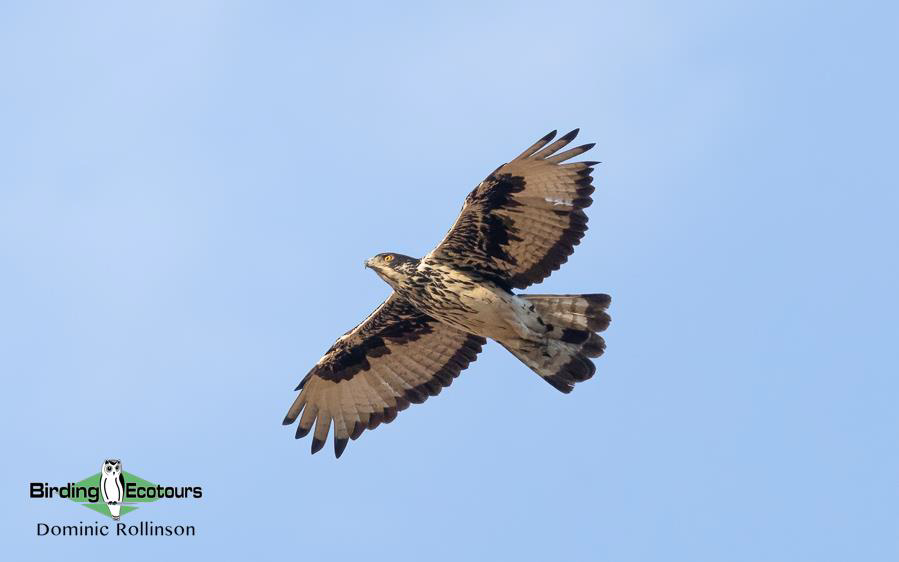
African Hawk-Eagles were regularly seen in the Mhara concession.
In the more open areas while birding along dry riverbeds, we further added African Hawk-Eagle, Tawny and Booted Eagles, Dickinson’s Kestrel (well spotted by Angie), Augur Buzzard, Double-banded Sandgrouse, Swainson’s Spurfowl, Grey-headed Kingfisher, Southern Carmine and White-fronted Bee-eaters, Mottled Spinetail, Racket-tailed Roller, Levaillant’s, Jacobin and Black Cuckoos, Mosque Swallow, Meyer’s Parrot and Meves’s Starling.
The woodlands held small flocks of one of our other major targets, Lilian’s Lovebird, which were frequently seen flying noisily by. These woodlands also held Brown Snake Eagle, Pearl-spotted Owlet, Grey Go-away-bird, Eurasian Hoopoe, Green Wood Hoopoe, Common Scimitarbill, Grey-headed Bushshrike, Yellow-fronted Tinkerbird and Brown-crowned Tchagra. We encountered decent numbers of animals in these areas including Bush Hyrax, African Buffalo, African Elephant, Lion, Kudu, Klipspringer and Sharpe’s Grysbok.
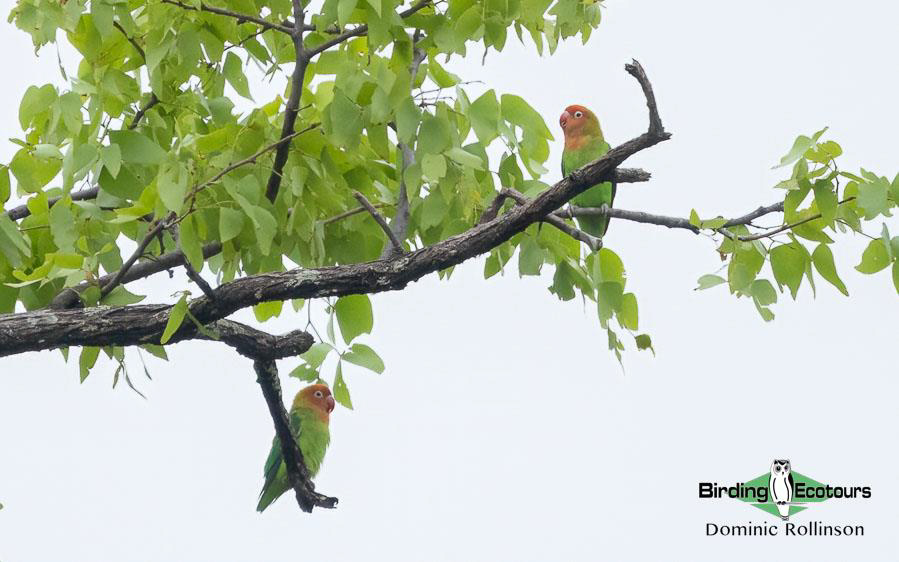
Lilian’s Lovebird, another major target around Mana Pools.
We spent an enjoyable day out at Mana Pools itself, along the Zambezi River, which was just full of birds. The drive to Mana Pools added Bat Hawk, Martial Eagle, Shikra, Eurasian Hobby, Amur Falcon, Black Stork, Arnot’s Chat, Eurasian Golden Oriole, and Cinnamon-breasted Bunting. Birding the various pools and the Zambezi floodplain at Mana Pools was exceptional and added many new birds to the trip list. Some of our highlights here included Bohm’s Spinetail, Water Thick-knee, White-crowned Lapwing, Saddle-billed Stork, Little Heron, Goliath Heron, White-headed, Lappet-faced, White-backed and Hooded Vultures, Woodland Kingfisher, Lilac-breasted Roller, Bearded and Bennett’s Woodpecker, Retz’s Helmetshrike, Red-billed Oxpecker and White-browed Sparrow-Weaver.
It was not all about birding today though, as we tried our best to track down African Wild Dogs, which had been seen in the area over the last few weeks. After a few hours in the area, we eventually struck gold when Liam spotted some distant shapes, which turned out to be a pack of African Wild Dogs. We quietly approached on foot (approaching animals on foot with a ranger is allowed in Mana Pools) and were able to sit nearby to a small pack of dogs, which were completely at ease with our presence – a surreal experience and Larry’s most wanted animal of the trip! While watching the dogs, we had further good looks at a few Hooded Vultures, which often accompany the dogs. The impressive woodlands held good numbers of African Elephants, although we did not get the hoped-for looks of male elephants standing on their hind legs to feed from the tall woodlands. Other interesting wildlife seen here included Giraffe, Chacma Baboon, Side-striped Jackal, Common Eland, Impala and Waterbuck.
We enjoyed night drives on most evenings during our time at Mhara River Camp, where we came across some exciting nocturnal birds, such as Pennant-winged and Square-tailed Nightjars, Verreaux’s Eagle-Owl and Bronze-winged Courser. Other nocturnal animals seen included Large-spotted Genet, Southern Lesser Galago and a group of three male Lions.
We were also kept on our toes with sightings of a couple of Black Mambas (a highly venomous snake) around the concession, much to Curt’s delight!
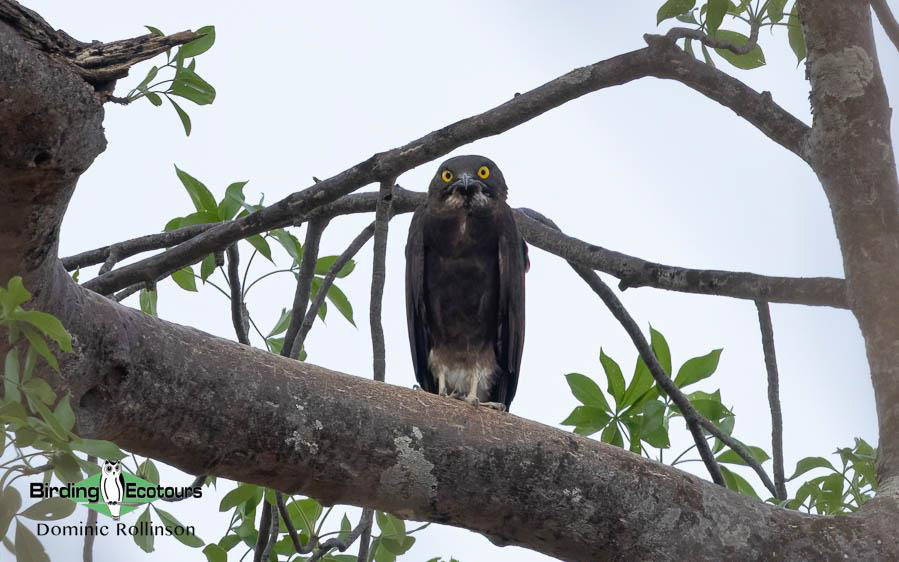
Bat Hawk seen at its day roost near Mana Pools.
Day 6, 26th November 2024. Transfer to Harare
After four fantastic nights and days at Mhara River Camp we bade farewell to Jim, Liam and the Mhara team and slowly made our way back south towards Harare. On our final game drive out of camp, we saw good numbers of Long-tailed Paradise Whydahs and said goodbye to the ubiquitous Meves’s Starlings and Southern Red-billed Hornbills which we had become so familiar with over the last few days.
The drive back to Harare was mostly uneventful, nevertheless, we did include a late afternoon stop to look for Rosy-throated Longclaw, which duly obliged and provided good looks for us all. Other distractions here included Abdim’s Stork, African Wattled Lapwing, Black-crowned Night Heron and Red-breasted Swallow. We eventually made it back to our guest house in Harare in the late afternoon, excited about the prospect of the next couple of days of miombo birding.
Day 7, 27th November 2024. Harare birding
This morning we left early and headed to a nearby airstrip, where we birded the adjoining grassland and marshy areas. The birding here was great and over the next hour or so we added the likes of Rosy-throated, Cape and Yellow-throated Longclaws, Pale-crowned, Levaillant’s, Croaking and Zitting Cisticolas, Yellow-mantled Widowbird, Quailfinch and Pin-tailed Whydah. The undoubted highlight was seeing an estimated 20 Marsh Owls which kept flushing from a nearby field, providing us with fantastic views – we even managed views of a bird sat in the grass!
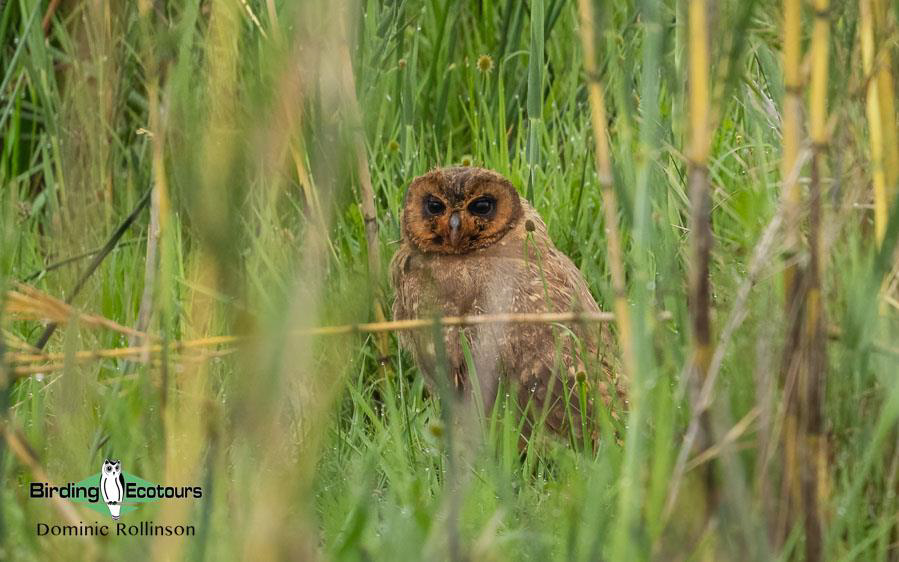
Impressive numbers of Marsh Owls were seen outside of Harare.
Next up was miombo birding at nearby Christon Bank. As is often the case with miombo birding, we went through some very quiet periods over the next couple of hours, interspersed with some very productive and frenetic periods when we found bird parties which were full of feeding birds. Some of our highlights at Christon Bank included Boulder Chat (the star species here), Lizard Buzzard, Crested Barbet, Yellow-fronted Tinkerbird, Cardinal Woodpecker, Black Cuckooshrike, Southern Hyliota, Red-faced Crombec, Rock-loving Cisticola, Southern Yellow White-eye, Ashy Flycatcher, Eastern Miombo Sunbird, Striped Pipit and Streaky-headed Seedeater. After a good couple of hours of walking the paths through the miombo woodlands, we decided to head back to Harare for lunch.
After lunch we headed back out and this time made our way to the eastern edge of the city, where we birded Haka Park for the remainder of the afternoon. We spent our time here birding the miombo woodlands, grassland patches and small dam. The woodlands were mostly quiet, but we did manage to eke out Whyte’s Barbet, Purple-crested Turaco, White-crested Helmetshrike, Green-capped Eremomela, Bar-throated Apalis, Southern Yellow White-eye and Yellow-fronted Canary. The grassland and wetland areas further held White-backed Duck, Black Crake, African Snipe, Abdim’s Stork and a small flock of Orange-breasted Waxbills.

Boulder Chat was seen easily at Christon Bank.
Day 8, 28th November 2024. Harare to Eastern Highlands
We left Harare early this morning, as we wanted to bird Gosho Park, near Marondera, about 50 miles (80 kilometers) southwest of Harare, before things heated up too much. Gosho Park represents about the best miombo birding close to Harare and, as we were still missing many of the miombo specials, we ended up spending most of the morning birding here. As always, miombo birding is hard work but, thankfully, there were many feeding flocks around and our careful examination of these flocks paid off. Highlights throughout the morning included Striped Kingfisher, Whyte’s Barbet, Yellow-fronted Tinkerbird, Lesser Honeyguide, White-breasted Cuckooshrike, Brubru, Southern Hyliota, Miombo Tit, Grey Penduline Tit, Pale Flycatcher, Mocking Cliff Chat, Eastern Miombo Sunbird, Wood, Striped and Tree Pipits, and Black-eared and Streaky-headed Seedeaters. We heard the high-pitched calls of African Spotted Creeper but, unfortunately, we could not lay eyes on this most-wanted special (for now). While birding around Gosho Park we also found the colorful Kirk’s Agama clambering on the area’s many granite ‘koppies’.
We had our lunch en route to the eastern Highlands and managed to add a showy pair of Jameson’s Firefinch as a nice bonus. We made a quick stop on the Christmas Pass at Cecil Kop Nature Reserve, above Mutare, to try to eke out a few more miombo targets. The woodlands were very quiet, but just before we left, we managed to find a calling Miombo Rock Thrush and then struck gold with a showy Rufous-bellied Tit (the recently lumped, Cinnamon-breasted subspecies) as well as a distant Cabanis’s Bunting.
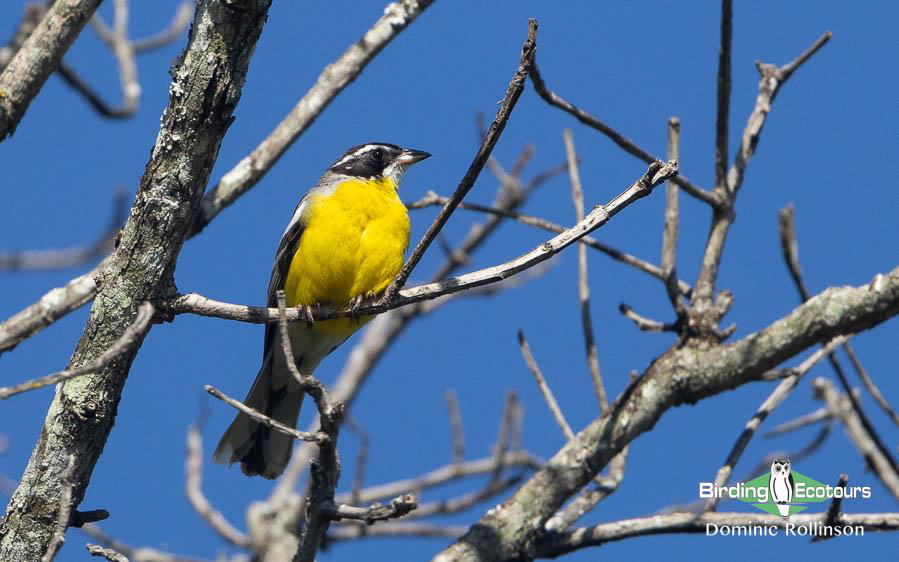
Cabanis’s Bunting was frequently encountered in eastern Zimbabwe.
From here we ascended for the final hour or so into the Bvumba Mountains, adding Cape Canary and Blue-spotted Wood Dove on the drive, before taking it easy for the remainder of the afternoon around Seldomseen Cottages.
Day 9, 29th November 2024. Bvumba Mountains birding
We awoke this morning to heavy rain and mist (Seldomseen living up to its name) which made birding tough, nevertheless, we persevered and managed to find many of our forest targets. Local bird guide, Bulawesi, joined us for the day and, with his expertise, we were in very safe hands. Birding around the grounds is always a great way to start the day and, despite the bad weather, we still managed to find Lemon, Tambourine and Blue-spotted Wood Doves, Livingstone’s Turaco, Yellow-rumped Tinkerbird, Cape Batis, Olive and Black-fronted Bushshrikes, White-tailed Crested Flycatcher, Roberts’s Warbler, Chirinda Apalis, Barratt’s Warbler, Black Saw-wing, Stripe-cheeked and Yellow-streaked Greenbuls, Orange Ground and Olive Thrushes, Red-capped and Cape Robin-Chats, White-starred Robin, Olive, Bronze and Variable Sunbirds and Yellow-bellied Waxbill. The highlight of our pre-breakfast birding was a relatively showy Red-faced Crimsonwing, normally a nightmare to see, since they feed high up in the forest canopy. Both Swynnerton’s Robin and Buff-spotted Flufftail were heard calling but, unfortunately, neither would show for us. Mutable Sun Squirrels were also seen high up in the forest canopy.
After a tasty breakfast we headed out to bird a nearby patch of miombo woodland where African Spotted Creeper would be our major target. Bulawesi had recently seen a pair feeding a juvenile in this area and, after a while, we heard the high-pitched wispy calls of the creeper and, after a brief search, we found an adult feeding a begging juvenile. We watched the birds for a while as the juvenile followed the adult up and down the trunks of trees and had fantastic looks at this most-wanted miombo special. Other highlights seen in the woodlands included Brown-backed Honeybird, Southern Hyliota, Miombo Tit, Red-faced Crombec, Wailing Cisticola, Southern Yellow White-eye, Miombo Rock Thrush, Wood Pipit, Cabanis’s Bunting and a few showy Western Violet-backed Sunbirds, which is often a very tricky species to track down! After we got back to our accommodation, Bulawesi showed us a juvenile Marshall’s Dwarf Chameleon.

African Spotted Creeper took some finding but eventually showed well in the Bvumba Mountains.
It had been a long and wet morning out, but we had been highly successful, and after another enjoyable lunch we dried out around the fire and took some time off. Later that afternoon we headed out again with Swynnerton’s Robin being the major target. Thankfully, Bulawesi knew the location of a few Swynnerton’s Robin territories and after much work, we eventually managed to get looks at a male, although trying to photograph it was another story. In Bunga Forest we also found Grey Cuckooshrike, Gorgeous Bushshrike, Livingstone’s Turaco and Burchell’s Coucal. Birding the nearby grassland patches further added Cape Grassbird, Wailing Cisticola and African Yellow Warbler. After a long day out, we headed back to Seldomseen Cottages for the evening.
Day 10, 30th November 2024. Bvumba Mountains to Honde Valley
We woke up to slightly improved weather this morning which continued to improve as the morning progressed. We headed out before breakfast to try and find Buff-spotted Flufftail which were again calling in the nearby forest. Again, despite our best efforts, we could not lay eyes on these supreme forest skulkers. Some of us did, however, have our breakfast interrupted by a calling Eastern Bronze-naped Pigeon which did a quick flyby for us.
It was then time to pack up, with a couple stops on our way out to try to improve our looks of Swynnerton’s Robin. We again had brief looks, and somehow Shailesh managed a lovely shot of a smart male!
We then made our way back north through Mutare and headed into the picturesque and vast highlands of Nyanga National Park. As we drove through the rolling hills, we saw birds such as Long-crested Eagle and Southern Fiscal while a quick stop at a roadside dam added African Black Duck, Little Grebe, Malachite Kingfisher and White-throated Swallow. However, the reason for our trip to Nyanga was to find the rare Blue Swallow. We visited a known nest site and saw an adult Blue Swallow flying back and forth, as it busily chased off a Black Saw-wing which was likely trying to use its nest hole. Unfortunately, the Blue Swallow did not perch out in the open for us, but we did get good views as it flew around us. In the surrounding grasslands we also found Cape Grassbird, Wailing Cisticola and saw a couple African Olive Pigeons flying overhead.
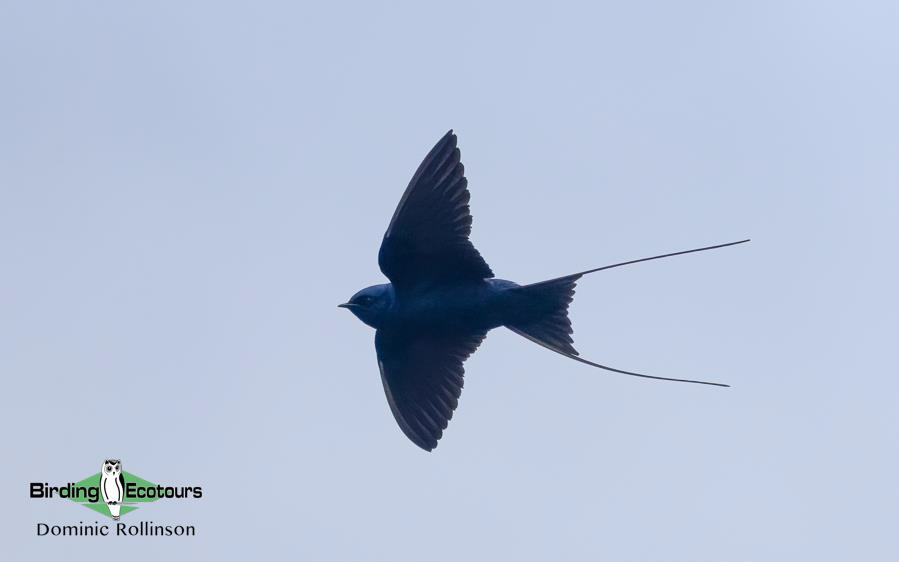
We had good flight views of Blue Swallow in the Nyanga Highlands.
From Nyanga, we made the long drive back south and then through the Honde Valley. We eventually arrived at the beautifully set Aberfoyle Lodge after what had been a long day in the vehicle. As we were checking in, a couple massive Silvery-cheeked Hornbills flew overhead. A few of us stretched our legs with a walk around the golf course, where we saw Palm-nut Vulture, Burchell’s Coucal, Black-throated Wattle-eye and Mountain Wagtail.
Day 11, 1st December 2024. Honde Valley birding
This morning we had our earliest start yet, as we headed to the nearby Katiyo Tea Estate to look for several lowland specials which are more typically associated with birding tours to Mozambique, but which are gettable in the Honde Valley. We arrived soon after sunrise and immediately got to work on finding our target species. Morgan, the local bird guide from Aberfoyle, was thankfully joining us this morning and his knowledge of the area’s birds was invaluable. Highlights from our morning’s birding around the tea estate included Red-necked Spurfowl, Blue-spotted Wood Dove, Livingstone’s Turaco, Corn Crake, Small Buttonquail, Red-necked Falcon, Pale Batis, Moustached Grass Warbler, Fan-tailed Grassbird, Red-winged Prinia, Singing and Short-winged Cisticolas, Holub’s Golden Weaver, Black-winged and Yellow Bishops, African Firefinch and Cabanis’s Bunting. We tried hard for Lesser Seedcracker, but despite Morgan seeing them regularly over the last couple of weeks, they were a no-show today!
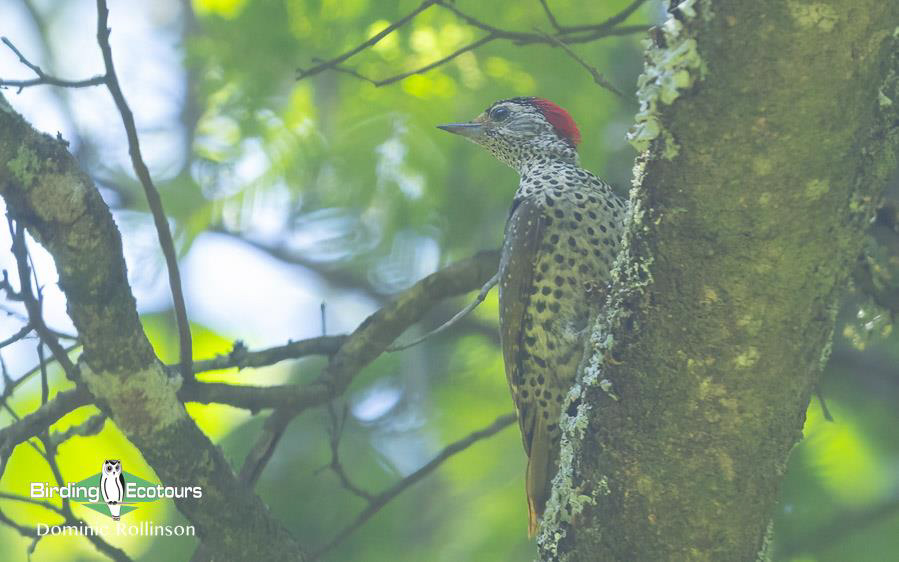
Little Spotted Woodpecker showed well in the Honde Valley.
We stopped at Pungwe Forest on the way back to the lodge and got lucky with an obliging pair of showy Little Spotted Woodpeckers. We got back to the Aberfoyle Lodge in the late morning and decided to have a quick look for Pallid Honeyguide before lunch. We immediately heard the bird calling from a massive tree, but it wasn’t showing easily, and we had to spend some time to eventually all lay eyes on it. Other birds seen while looking for the honeyguide included Dark-backed Weaver and Grey Waxbill.
After lunch we took some time off and waited at the feeder for seed-eating species to come down and feed. With patient waiting we managed to see Red-throated and Green Twinspots, Magpie Mannikin and more Grey Waxbills.

We enjoyed a variety of seedeaters at Aberfoyle Lodge, including this male Red-throated Twinspot.
That afternoon we headed out to nearby Wamba Marsh where we tried for Marsh Tchagra, without success, unfortunately the birds were just not around this afternoon. We did, however, have some good birding in the general area though and notched up Tambourine Dove, Scarce, Mottled and White-rumped Swifts, Black-chested Snake Eagle, Eurasian Golden Oriole, Wire-tailed and Grey-rumped Swallows, Western House Martin and Black-and-white Mannikin.
Day 12, 2nd December 2024. Transfer back to Harare
For our last bit of proper scheduled birding for the tour, we took a walk around the property to see what else we could eke out. Most of the species were repeat views from yesterday, with some of the highlights including Red-necked Spurfowl, African Pygmy Kingfisher, White-eared Barbet, Green-backed Woodpecker, Black-throated Wattle-eye, Black-fronted Bushshrike, Singing Cisticola, Yellow-streaked Greenbul, Mountain Wagtail and Cabanis’s Bunting. A calling Narina Trogon played hide-and-seek with us, with only Shailesh laying eyes on the bird.
After breakfast, it was then time to hit the long road back to Harare. As we made our way out of the Honde Valley, Christiane spotted a perched Augur Buzzard which showed well for us. We made another quick stop at Pungwe Forest, which further added Blue-mantled Crested Flycatcher, Bearded Scrub Robin and Red-capped Robin-Chat. We stopped in for an early lunch at a protea farm near Juliasdale but, unfortunately, without any proteas in bloom, there were none of the hoped-for Gurney’s Sugarbirds around.
The rest of the long drive back to Harare went by uneventfully and we arrived back in the late afternoon tired, but content, after a wonderful few days in the Eastern Highlands of Zimbabwe, with just about all our target birds seen.
Day 13, 3rd December 2024. Departure from Harare
We didn’t have any birding planned this morning and after our final breakfast we made our way to Harare Airport, where the tour ended. Thanks to everyone for making this tour such a successful and enjoyable one!

We had repeat views of a group of three male Lions near Mana Pools.
Bird List – Following IOC (Version 15.1/February 2025)
Birds ‘heard only’ are marked with (H) after the common name, all other species were seen.
The following notation after species names is used to show conservation status following BirdLife International: CE = Critically Endangered, EN = Endangered, VU = Vulnerable.
| Common name | Scientific name |
| Ducks, Geese, and Waterfowl (Anatidae) | |
| White-faced Whistling Duck | Dendrocygna viduata |
| Knob-billed Duck | Sarkidiornis melanotos |
| Egyptian Goose | Alopochen aegyptiaca |
| Spur-winged Goose | Plectropterus gambensis |
| African Black Duck | Anas sparsa |
| Red-billed Teal | Anas erythrorhyncha |
| Guineafowl (Numididae) | |
| Helmeted Guineafowl | Numida meleagris |
| Southern Crested Guineafowl | Guttera edouardi |
| Pheasants, Grouse, and Allies (Phasianidae) | |
| Crested Francolin | Ortygornis sephaena |
| Natal Spurfowl | Pternistis natalensis |
| Swainson’s Spurfowl | Pternistis swainsonii |
| Red-necked Spurfowl | Pternistis afer |
| Pigeons and Doves (Columbidae) | |
| Rock Dove | Columba livia |
| African Olive Pigeon | Columba arquatrix |
| Eastern Bronze-naped Pigeon | Columba delegorguei |
| Lemon Dove | Aplopelia larvata |
| Red-eyed Dove | Streptopelia semitorquata |
| Ring-necked Dove | Streptopelia capicola |
| Laughing Dove | Spilopelia senegalensis |
| Emerald-spotted Wood Dove | Turtur chalcospilos |
| Blue-spotted Wood Dove | Turtur afer |
| Tambourine Dove | Turtur tympanistria |
| Sandgrouse (Pteroclidae) | |
| Double-banded Sandgrouse | Pterocles bicinctus |
| Turacos (Musophagidae) | |
| Grey Go-away-bird | Crinifer concolor |
| Purple-crested Turaco | Gallirex porphyreolophus |
| Livingstone’s Turaco | Tauraco livingstonii |
| Cuckoos (Cuculidae) | |
| Senegal Coucal | Centropus senegalensis |
| White-browed Coucal (H) | Centropus superciliosus |
| Burchell’s Coucal | Centropus burchellii |
| Levaillant’s Cuckoo | Clamator levaillantii |
| Jacobin Cuckoo | Clamator jacobinus |
| Diederik Cuckoo | Chrysococcyx caprius |
| Klaas’s Cuckoo (H) | Chrysococcyx klaas |
| African Emerald Cuckoo (H) | Chrysococcyx cupreus |
| Black Cuckoo | Cuculus clamosus |
| Red-chested Cuckoo | Cuculus solitarius |
| Nightjars and Allies (Caprimulgidae) | |
| Pennant-winged Nightjar | Caprimulgus vexillarius |
| Fiery-necked Nightjar (H) | Caprimulgus pectoralis |
| Square-tailed Nightjar | Caprimulgus fossii |
| Swifts (Apodidae) | |
| Mottled Spinetail | Telacanthura ussheri |
| Böhm’s Spinetail | Neafrapus boehmi |
| Scarce Swift | Schoutedenapus myoptilus |
| Mottled Swift | Tachymarptis aequatorialis |
| Common Swift | Apus apus |
| Little Swift | Apus affinis |
| Horus Swift | Apus horus |
| White-rumped Swift | Apus caffer |
| African Palm Swift | Cypsiurus parvus |
| Flufftails (Sarothruridae) | |
| Buff-spotted Flufftail (H) | Sarothrura elegans |
| Red-chested Flufftail (H) | Sarothrura rufa |
| Rails, Gallinules, and Coots (Rallidae) | |
| Corn Crake | Crex crex |
| Common Moorhen | Gallinula chloropus |
| Red-knobbed Coot | Fulica cristata |
| Black Crake | Zapornia flavirostra |
| Thick-knees (Burhinidae) | |
| Water Thick-knee | Burhinus vermiculatus |
| Stilts and Avocets (Recurvirostridae) | |
| Black-winged Stilt | Himantopus himantopus |
| Plovers and Lapwings (Charadriidae) | |
| Three-banded Plover | Thinornis tricollaris |
| Blacksmith Lapwing | Vanellus armatus |
| White-crowned Lapwing | Vanellus albiceps |
| Crowned Lapwing | Vanellus coronatus |
| African Wattled Lapwing | Vanellus senegallus |
| Kittlitz’s Plover | Anarhynchus pecuarius |
| Jacanas (Jacanidae) | |
| African Jacana | Actophilornis africanus |
| Sandpipers and Allies (Scolopacidae) | |
| Common Sandpiper | Actitis hypoleucos |
| Marsh Sandpiper | Tringa stagnatilis |
| Wood Sandpiper | Tringa glareola |
| Common Greenshank | Tringa nebularia |
| Ruff | Calidris pugnax |
| Buttonquail (Turnicidae) | |
| Common (Kurrichane) Buttonquail | Turnix sylvaticus |
| Pratincoles and Coursers (Glareolidae) | |
| Bronze-winged Courser | Rhinoptilus chalcopterus |
| Three-banded Courser | Rhinoptilus cinctus |
| Grebes (Podicipedidae) | |
| Dabchick (Little Grebe) | Tachybaptus ruficollis |
| Storks (Ciconiidae) | |
| African Openbill | Anastomus lamelligerus |
| Black Stork | Ciconia nigra |
| Abdim’s Stork | Ciconia abdimii |
| African Woolly-necked Stork | Ciconia microscelis |
| White Stork | Ciconia ciconia |
| Saddle-billed Stork | Ephippiorhynchus senegalensis |
| Marabou Stork | Leptoptilos crumenifer |
| Yellow-billed Stork | Mycteria ibis |
| Anhingas (Anhingidae) | |
| African Darter | Anhinga rufa |
| Cormorants and Shags (Phalacrocoracidae) | |
| Reed Cormorant | Microcarbo africanus |
| Ibises and Spoonbills (Threskiornithidae) | |
| Glossy Ibis | Plegadis falcinellus |
| African Sacred Ibis | Threskiornis aethiopicus |
| Hadeda Ibis | Bostrychia hagedash |
| Herons, Egrets, and Bitterns (Ardeidae) | |
| Black-crowned Night Heron | Nycticorax nycticorax |
| Black Heron | Egretta ardesiaca |
| Little Egret | Egretta garzetta |
| Little Heron | Butorides atricapilla |
| Squacco Heron | Ardeola ralloides |
| Western Cattle Egret | Ardea ibis |
| Great Egret | Ardea alba |
| Yellow-billed Egret | Ardea brachyrhyncha |
| Grey Heron | Ardea cinerea |
| Purple Heron | Ardea purpurea |
| Black-headed Heron | Ardea melanocephala |
| Goliath Heron | Ardea goliath |
| Hamerkop (Scopidae) | |
| Hamerkop | Scopus umbretta |
| Hawks, Eagles, and Kites (Accipitridae) | |
| Black-winged Kite | Elanus caeruleus |
| African Harrier-Hawk | Polyboroides typus |
| Palm-nut Vulture | Gypohierax angolensis |
| White-headed Vulture – CR | Trigonoceps occipitalis |
| Lappet-faced Vulture – EN | Torgos tracheliotos |
| Hooded Vulture – CR | Necrosyrtes monachus |
| White-backed Vulture – CR | Gyps africanus |
| Bateleur – EN | Terathopius ecaudatus |
| Western Banded Snake Eagle (H) | Circaetus cinerascens |
| Black-chested Snake Eagle | Circaetus pectoralis |
| Brown Snake Eagle | Circaetus cinereus |
| Martial Eagle – EN | Polemaetus bellicosus |
| Long-crested Eagle | Lophaetus occipitalis |
| Wahlberg’s Eagle | Hieraaetus wahlbergi |
| Booted Eagle | Hieraaetus pennatus |
| Tawny Eagle – VU | Aquila rapax |
| African Hawk-Eagle | Aquila spilogaster |
| Bat Hawk | Macheiramphus alcinus |
| Gabar Goshawk | Micronisus gabar |
| Lizard Buzzard | Kaupifalco monogrammicus |
| African Goshawk | Aerospiza tachiro |
| Little Sparrowhawk | Tachyspiza minulla |
| Shikra | Tachyspiza badia |
| Yellow-billed Kite | Milvus migrans |
| African Fish Eagle | Icthyophaga vocifer |
| Augur Buzzard | Buteo augur |
| Common Buzzard | Buteo buteo |
| Owls (Strigidae) | |
| Verreaux’s Eagle-Owl | Ketupa lactea |
| Pearl-spotted Owlet (H) | Glaucidium perlatum |
| African Barred Owlet (H) | Glaucidium capense |
| African Wood Owl (H) | Strix woodfordii |
| Marsh Owl | Asio capensis |
| Mousebirds (Coliidae) | |
| Speckled Mousebird | Colius striatus |
| Red-faced Mousebird | Urocolius indicus |
| Trogons (Trogonidae) | |
| Narina Trogon (H) | Apaloderma narina |
| Hoopoes (Upupidae) | |
| Eurasian Hoopoe | Upupa epops |
| Woodhoopoes and Scimitarbills (Phoeniculidae) | |
| Green Wood-hoopoe | Phoeniculus purpureus |
| Common Scimitarbill | Rhinopomastus cyanomelas |
| Hornbills (Bucerotidae) | |
| Crowned Hornbill | Lophoceros alboterminatus |
| African Grey Hornbill | Lophoceros nasutus |
| Southern Red-billed Hornbill | Tockus rufirostris |
| Silvery-cheeked Hornbill | Bycanistes brevis |
| Trumpeter Hornbill | Bycanistes bucinator |
| Bee-eaters (Meropidae) | |
| White-fronted Bee-eater | Merops bullockoides |
| Little Bee-eater | Merops pusillus |
| European Bee-eater | Merops apiaster |
| Southern Carmine Bee-eater | Merops nubicoides |
| Kingfishers (Alcedinidae) | |
| Malachite Kingfisher | Corythornis cristatus |
| African Pygmy Kingfisher | Ispidina picta |
| Grey-headed Kingfisher | Halcyon leucocephala |
| Woodland Kingfisher | Halcyon senegalensis |
| Brown-hooded Kingfisher | Halcyon albiventris |
| Striped Kingfisher | Halcyon chelicuti |
| Pied Kingfisher | Ceryle rudis |
| Rollers (Coraciidae) | |
| European Roller | Coracias garrulus |
| Lilac-breasted Roller | Coracias caudatus |
| Racket-tailed Roller | Coracias spatulatus |
| Broad-billed Roller | Eurystomus glaucurus |
| African Barbets (Lybiidae) | |
| Crested Barbet | Trachyphonus vaillantii |
| White-eared Barbet | Stactolaema leucotis |
| Whyte’s Barbet | Stactolaema whytii |
| Yellow-rumped Tinkerbird | Pogoniulus bilineatus |
| Yellow-fronted Tinkerbird | Pogoniulus chrysoconus |
| Black-collared Barbet | Lybius torquatus |
| Honeyguides (Indicatoridae) | |
| Brown-backed Honeybird | Prodotiscus regulus |
| Pallid Honeyguide | Indicator meliphilus |
| Lesser Honeyguide | Indicator minor |
| Greater Honeyguide | Indicator indicator |
| Woodpeckers (Picidae) | |
| Bearded Woodpecker | Chloropicus namaquus |
| Cardinal Woodpecker | Dendropicos fuscescens |
| Little Spotted Woodpecker | Campethera maculosa |
| Bennett’s Woodpecker | Campethera bennettii |
| Golden-tailed Woodpecker | Campethera abingoni |
| Falcons and Caracaras (Falconidae) | |
| Dickinson’s Kestrel | Falco dickinsoni |
| Red-necked Falcon | Falco chicquera |
| Amur Falcon | Falco amurensis |
| Eurasian Hobby | Falco subbuteo |
| Lanner Falcon | Falco biarmicus |
| Old World Parrots (Psittaculidae) | |
| Lilian’s Lovebird | Agapornis lilianae |
| New World and African Parrots (Psittacidae) | |
| Meyer’s Parrot | Poicephalus meyeri |
| African and Green Broadbills (Calyptomenidae) | |
| African Broadbill | Smithornis capensis |
| Pittas (Pittidae) | |
| African Pitta | Pitta angolensis |
| Cuckooshrikes (Campephagidae) | |
| Grey Cuckooshrike | Ceblepyris caesius |
| White-breasted Cuckooshrike | Ceblepyris pectoralis |
| Black Cuckooshrike | Campephaga flava |
| Old World Orioles (Oriolidae) | |
| Eurasian Golden Oriole | Oriolus oriolus |
| African Golden Oriole | Oriolus auratus |
| Black-headed Oriole | Oriolus larvatus |
| Wattle-eyes and Batises (Platysteiridae) | |
| Black-throated Wattle-eye | Platysteira peltata |
| Cape Batis | Batis capensis |
| Chinspot Batis | Batis molitor |
| Pale Batis | Batis soror |
| Vangas, Helmetshrikes, and Allies (Vangidae) | |
| White-crested Helmetshrike | Prionops plumatus |
| Retz’s Helmetshrike | Prionops retzii |
| Bushshrikes and Allies (Malaconotidae) | |
| Brubru | Nilaus afer |
| Black-backed Puffback | Dryoscopus cubla |
| Black-crowned Tchagra | Tchagra senegalus |
| Brown-crowned Tchagra | Tchagra australis |
| Tropical Boubou | Laniarius major |
| Gorgeous Bushshrike | Telophorus viridis |
| Orange-breasted Bushshrike (H) | Chlorophoneus sulfureopectus |
| Olive Bushshrike | Chlorophoneus olivaceus |
| Black-fronted Bushshrike | Chlorophoneus nigrifrons |
| Grey-headed Bushshrike | Malaconotus blanchoti |
| Drongos (Dicruridae) | |
| Square-tailed Drongo | Dicrurus ludwigii |
| Fork-tailed Drongo | Dicrurus adsimilis |
| Monarch Flycatchers (Monarchidae) | |
| Blue-mantled Crested Flycatcher | Trochocercus cyanomelas |
| African Paradise Flycatcher | Terpsiphone viridis |
| Shrikes (Laniidae) | |
| Red-backed Shrike | Lanius collurio |
| Southern Fiscal | Lanius collaris |
| Crows, Jays, and Magpies (Corvidae) | |
| Pied Crow | Corvus albus |
| White-necked Raven | Corvus albicollis |
| Hyliotas (Hyliotidae) | |
| Southern Hyliota | Hyliota australis |
| Fairy Flycatchers (Stenostiridae) | |
| White-tailed Crested Flycatcher | Elminia albonotata |
| Tits, Chickadees, and Titmice (Paridae) | |
| Rufous-bellied Tit | Melaniparus rufiventris |
| Southern Black Tit | Melaniparus niger |
| Miombo Tit | Melaniparus griseiventris |
| Penduline-Tits (Remizidae) | |
| Grey Penduline-tit | Anthoscopus caroli |
| Larks (Alaudidae) | |
| Rufous-naped Lark | Corypha africana |
| Nicators (Nicatoridae) | |
| Eastern Nicator (H) | Nicator gularis |
| African Warblers (Macrosphenidae) | |
| Red-faced Crombec | Sylvietta whytii |
| Long-billed Crombec | Sylvietta rufescens |
| Moustached Grass Warbler | Melocichla mentalis |
| Cape Grassbird | Sphenoeacus afer |
| Cisticolas and Allies (Cisticolidae) | |
| Green-capped Eremomela | Eremomela scotops |
| Roberts’s Warbler | Oreophilais robertsi |
| Stierling’s Wren-Warbler (H) | Calamonastes stierlingi |
| Grey-backed Camaroptera | Camaroptera brachyura |
| Bar-throated Apalis | Apalis thoracica |
| Yellow-breasted Apalis | Apalis flavida |
| Chirinda Apalis – VU | Apalis chirindensis |
| Tawny-flanked Prinia | Prinia subflava |
| Red-winged Warbler | Prinia erythroptera |
| Red-faced Cisticola | Cisticola erythrops |
| Singing Cisticola | Cisticola cantans |
| Rock-loving Cisticola | Cisticola aberrans |
| Rattling Cisticola | Cisticola chiniana |
| Wailing Cisticola | Cisticola lais |
| Levaillant’s Cisticola | Cisticola tinniens |
| Croaking Cisticola | Cisticola natalensis |
| Neddicky (H) | Cisticola fulvicapilla |
| Short-winged Cisticola | Cisticola brachypterus |
| Zitting Cisticola | Cisticola juncidis |
| Pale-crowned Cisticola | Cisticola cinnamomeus |
| Reed Warblers and Allies (Acrocephalidae) | |
| African Yellow Warbler | Iduna natalensis |
| Common Reed Warbler | Acrocephalus scirpaceus |
| Grassbirds and Allies (Locustellidae) | |
| Fan-tailed Grassbird | Catriscus brevirostris |
| Barratt’s Warbler | Bradypterus barratti |
| Little Rush Warbler | Bradypterus baboecala |
| Swallows (Hirundinidae) | |
| Black Saw-wing | Psalidoprocne pristoptera |
| Grey-rumped Swallow | Pseudhirundo griseopyga |
| Sand Martin | Riparia riparia |
| Blue Swallow – EN | Hirundo atrocaerulea |
| Barn Swallow | Hirundo rustica |
| White-throated Swallow | Hirundo albigularis |
| Wire-tailed Swallow | Hirundo smithii |
| Western House Martin | Delichon urbicum |
| Greater Striped Swallow | Cecropis cucullata |
| Lesser Striped Swallow | Cecropis abyssinica |
| Red-breasted Swallow | Cecropis semirufa |
| Mosque Swallow | Cecropis senegalensis |
| Bulbuls (Pycnonotidae) | |
| Sombre Greenbul | Andropadus importunus |
| Yellow-bellied Greenbul | Chlorocichla flaviventris |
| Stripe-cheeked Greenbul | Arizelocichla milanjensis |
| Yellow-streaked Greenbul | Phyllastrephus flavostriatus |
| Terrestrial Brownbul | Phyllastrephus terrestris |
| common bulbul sp. | Pycnonotus barbatus |
| Leaf Warblers (Phylloscopidae) | |
| Willow Warbler | Phylloscopus trochilus |
| Yellow Flycatchers (Erythrocercidae) | |
| Livingstone’s Flycatcher | Erythrocercus livingstonei |
| White-eyes, Yuhinas, and Allies (Zosteropidae) | |
| Southern Yellow White-eye | Zosterops anderssoni |
| Laughingthrushes and Allies (Leiothrichidae) | |
| Arrow-marked Babbler | Turdoides jardineii |
| Spotted Creepers (Salpornithidae) | |
| African Spotted Creeper | Salpornis salvadori |
| Oxpeckers (Buphagidae) | |
| Red-billed Oxpecker | Buphagus erythroryncha |
| Starlings (Sturnidae) | |
| Common Myna | Acridotheres tristis |
| Violet-backed Starling | Cinnyricinclus leucogaster |
| Red-winged Starling | Onychognathus morio |
| Meves’s Starling | Lamprotornis mevesii |
| Lesser Blue-eared Starling | Lamprotornis chloropterus |
| Cape Starling | Lamprotornis nitens |
| Thrushes and Allies (Turdidae) | |
| Boulder Chat | Pinarornis plumosus |
| Orange Ground Thrush | Geokichla gurneyi |
| Kurrichane Thrush | Turdus libonyana |
| Olive Thrush | Turdus olivaceus |
| Old World Flycatchers (Muscicapidae) | |
| African Dusky Flycatcher | Muscicapa adusta |
| Spotted Flycatcher | Muscicapa striata |
| Marico Flycatcher | Bradornis mariquensis |
| Pale Flycatcher | Agricola pallidus |
| Ashy Flycatcher | Fraseria caerulescens |
| Southern Black Flycatcher | Melaenornis pammelaina |
| Bearded Scrub Robin | Tychaedon quadrivirgata |
| White-browed Scrub Robin | Cercotrichas leucophrys |
| Cape Robin-Chat | Dessonornis caffer |
| White-browed Robin-Chat | Cossypha heuglini |
| Red-capped Robin-Chat | Cossypha natalensis |
| White-starred Robin | Pogonocichla stellata |
| Swynnerton’s Robin – VU | Swynnertonia swynnertoni |
| Miombo Rock Thrush | Monticola angolensis |
| African Stonechat | Saxicola torquatus |
| Mocking Cliff Chat | Thamnolaea cinnamomeiventris |
| Arnot’s Chat | Myrmecocichla arnotti |
| Familiar Chat | Oenanthe familiaris |
| Sunbirds and Spiderhunters (Nectariniidae) | |
| Western Violet-backed Sunbird | Anthreptes longuemarei |
| Collared Sunbird | Hedydipna collaris |
| Olive Sunbird | Cyanomitra olivacea |
| Amethyst Sunbird | Chalcomitra amethystina |
| Scarlet-chested Sunbird | Chalcomitra senegalensis |
| Bronze Sunbird | Nectarinia kilimensis |
| Eastern Miombo Sunbird | Cinnyris manoensis |
| White-bellied Sunbird | Cinnyris talatala |
| Variable Sunbird | Cinnyris venustus |
| Weavers and Allies (Ploceidae) | |
| White-browed Sparrow-Weaver | Plocepasser mahali |
| Red-headed Weaver | Anaplectes rubriceps |
| Spectacled Weaver | Ploceus ocularis |
| Holub’s Golden Weaver | Ploceus xanthops |
| Lesser Masked Weaver | Ploceus intermedius |
| Southern Masked Weaver | Ploceus velatus |
| Village Weaver | Ploceus cucullatus |
| Dark-backed Weaver | Ploceus bicolor |
| Red-billed Quelea | Quelea quelea |
| Southern Red Bishop | Euplectes orix |
| Black-winged Red Bishop | Euplectes hordeaceus |
| Yellow Bishop | Euplectes capensis |
| White-winged Widowbird | Euplectes albonotatus |
| Yellow-mantled Widowbird | Euplectes macroura |
| Red-collared Widowbird | Euplectes ardens |
| Thick-billed Weaver | Amblyospiza albifrons |
| Waxbills and Allies (Estrildidae) | |
| Bronze Mannikin | Spermestes cucullata |
| Magpie Mannikin | Spermestes fringilloides |
| Black-and-white Mannikin | Spermestes bicolor |
| Yellow-bellied Waxbill | Coccopygia quartinia |
| Green Twinspot | Mandingoa nitidula |
| Red-faced Crimsonwing | Cryptospiza reichenovii |
| Grey Waxbill | Glaucestrilda perreini |
| Common Waxbill | Estrilda astrild |
| Cut-throat Finch | Amadina fasciata |
| Orange-breasted Waxbill | Amandava subflava |
| Blue Waxbill | Uraeginthus angolensis |
| Green-winged Pytilia | Pytilia melba |
| Red-throated Twinspot | Hypargos niveoguttatus |
| Red-billed Firefinch | Lagonosticta senegala |
| African Firefinch | Lagonosticta rubricata |
| Jameson’s Firefinch | Lagonosticta rhodopareia |
| Indigobirds (Viduidae) | |
| Pin-tailed Whydah | Vidua macroura |
| Long-tailed Paradise Whydah | Vidua paradisaea |
| Old World Sparrows (Passeridae) | |
| House Sparrow | Passer domesticus |
| Southern Grey-headed Sparrow | Passer diffusus |
| Yellow-throated Bush Sparrow | Gymnoris superciliaris |
| Wagtails and Pipits (Motacillidae) | |
| Mountain Wagtail | Motacilla clara |
| African Pied Wagtail | Motacilla aguimp |
| African Pipit | Anthus cinnamomeus |
| Wood Pipit | Anthus nyassae |
| Buffy Pipit | Anthus vaalensis |
| Striped Pipit | Anthus lineiventris |
| Tree Pipit | Anthus trivialis |
| Cape Longclaw | Macronyx capensis |
| Yellow-throated Longclaw | Macronyx croceus |
| Rosy-throated Longclaw | Macronyx ameliae |
| Finches, Euphonias, and Allies (Fringillidae) | |
| Yellow-fronted Canary | Crithagra mozambica |
| Brimstone Canary | Crithagra sulphurata |
| Black-eared Seedeater | Crithagra mennelli |
| Streaky-headed Seedeater | Crithagra gularis |
| Cape Canary | Serinus canicollis |
| Old World Buntings (Emberizidae) | |
| Cabanis’s Bunting | Emberiza cabanisi |
| Golden-breasted Bunting | Emberiza flaviventris |
| Cinnamon-breasted Bunting | Emberiza tahapisi |
| Total seen | 348 |
| Total heard only | 15 |
| Total recorded | 363 |
Mammal List – Following Mammalwatching.com (November 2024)
The following notation after species names is used to show conservation status following IUCN Red List: EN = Endangered, VU = Vulnerable.
| Common name | Scientific name |
| Elephants (Elephantidae) | |
| African Savanna Elephant – EN | Loxodonta africana |
| Hyraxes (Procaviidae) | |
| Bush Hyrax | Heterohyrax brucei |
| Old World Monkeys (Cercopithecidae) | |
| Blue Monkey | Cercopithecus mitis |
| Vervet Monkey | Chlorocebus pygerythrus |
| Chacma Baboon | Papio ursinus |
| Galagos (Galagidae) | |
| Southern Lesser Galago | Galago moholi |
| Squirrels (Sciuridae) | |
| Mutable Sun Squirrel | Heliosciurus mutabilis |
| Smith’s Bush Squirrel | Paraxerus cepapi |
| Old World Fruit Bats (Pteropodidae) | |
| Peters’s Epauletted Fruit Bat | Epomophorus crypturus |
| Canids (Canidae) | |
| Side-striped Jackal | Lupulella adustus |
| African Wild Dog – EN | Lycaon pictus |
| Felids (Felidae) | |
| Lion – VU | Panthera leo |
| Mongooses (Herpestidae) | |
| Common Slender Mongoose | Herpestes sanguineus |
| Common Dwarf Mongoose | Helogale parvula |
| Civets, Genets, and Oyans (Viverridae) | |
| Rusty-spotted Genet | Genetta fieldiana |
| Equines (Equidae) | |
| Plains Zebra | Equus quagga |
| Bovids (Bovidae) | |
| Impala | Aepyceros melampus |
| Blue Wildebeest | Connochaetes taurinus |
| Sharpe’s Grysbok | Raphicerus sharpei |
| Blue Duiker | Philantomba monticola |
| Sable Antelope | Hippotragus niger |
| Klipspringer | Oreotragus oreotragus |
| Waterbuck | Kobus ellipsiprymnus |
| Cape Buffalo | Syncerus caffer |
| Common Eland | Tragelaphus oryx |
| Greater Kudu | Tragelaphus strepsiceros |
| Southern Bushbuck | Tragelaphus sylvaticus |
| Giraffes and Okapi (Giraffidae) | |
| Southern Giraffe | Giraffa giraffa |
| Suids (Suidae) | |
| Common Warthog | Phacochoerus africanus |
| Hippopotamuses (Hippopotamidae) | |
| Common Hippopotamus – VU | Hippopotamus amphibius |
| Total seen | 30 |
Reptile List Reptiles of World (October 2023)
The following notation after species names is used to show conservation status following IUCN Red List: VU = Vulnerable.
| Common name | Scientific name |
| Colubrid Snakes (Colubridae) | |
| Western Green Snake | Philothamnus angolensis |
| Elapid Snakes (Elapidae) | |
| Black Mamba | Dendroaspis polylepis |
| Dragons (Agamidae) | |
| Kirk’s Rock Agama | Agama kirkii |
| Southern Tree Agama | Acanthocercus atricollis |
| Chameleons (Chamaeleonidae) | |
| Flap-necked Chameleon | Chamaeleo dilepis |
| Marshall’s Pygmy Chameleon – VU | Rhampholeon marshalli |
| Skinks (Scincidae) | |
| Rainbow Skink | Trachylepis margaritifera |
| Wahlberg’s Striped Skink | Trachylepis wahlbergii |
| Monitor Lizards (Varanidae) | |
| Nile Monitor | Varanus niloticus |
| Total seen | 9 |
This is a sample trip report. Please email us ([email protected]) for more trip reports from this destination.
DOWNLOAD TRIP REPORT
